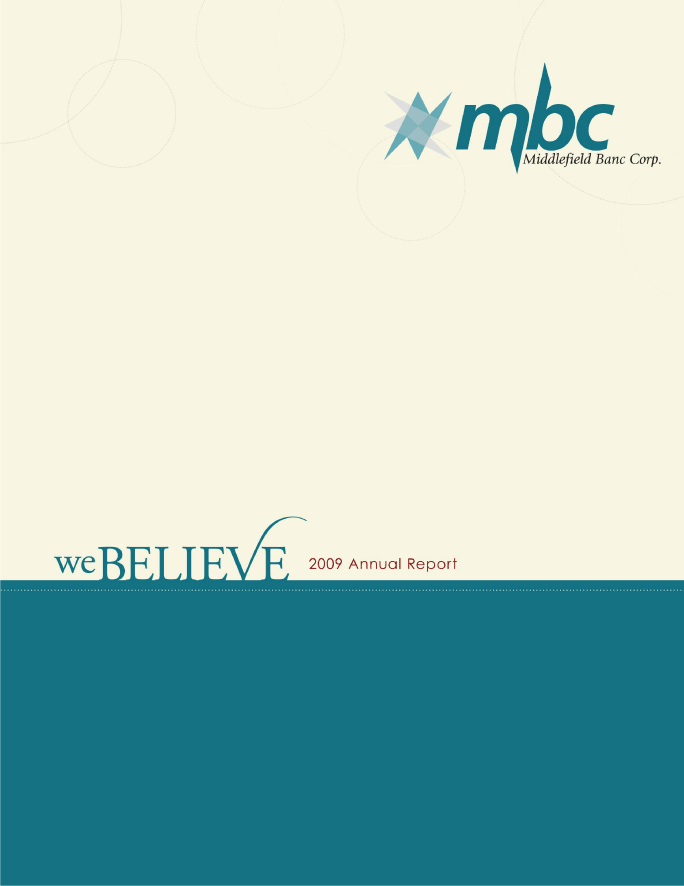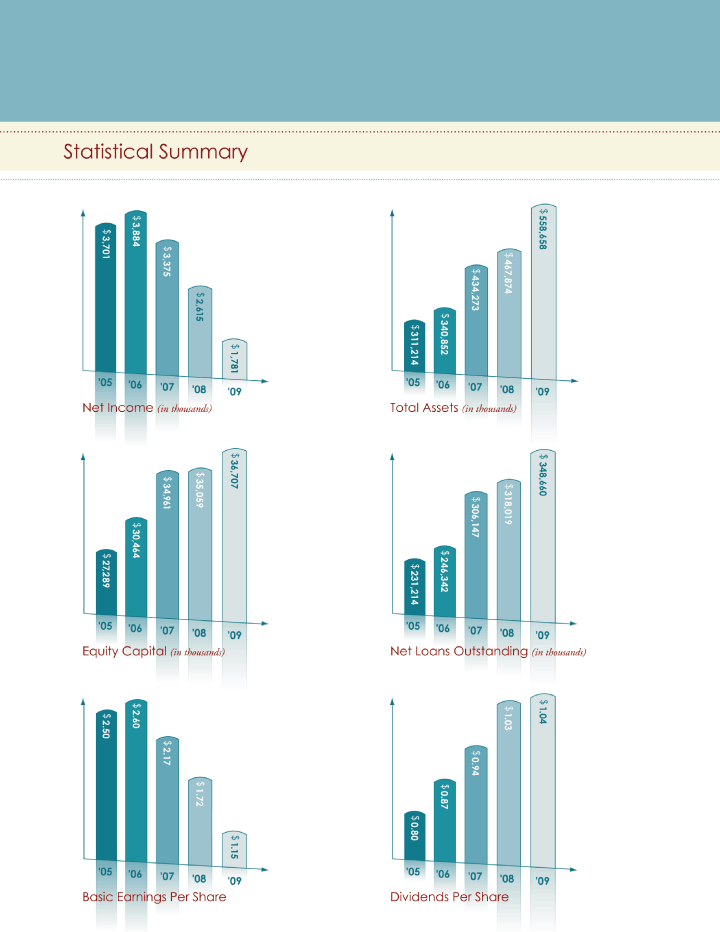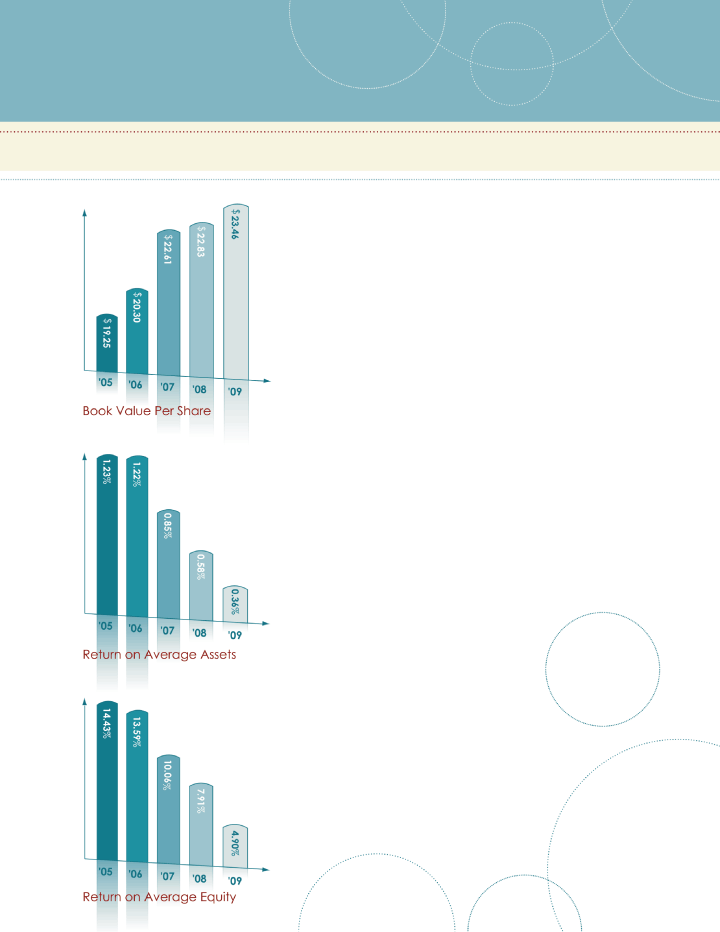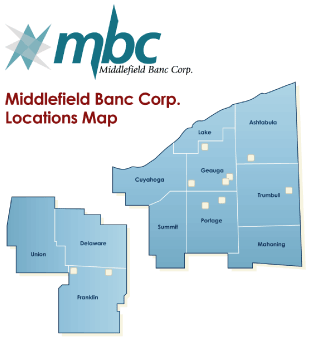Attached files
| file | filename |
|---|---|
| 10-K - FORM 10-K - MIDDLEFIELD BANC CORP | c97940e10vk.htm |
| EX-32 - EXHIBIT 32 - MIDDLEFIELD BANC CORP | c97940exv32.htm |
| EX-23 - EXHIBIT 23 - MIDDLEFIELD BANC CORP | c97940exv23.htm |
| EX-21 - EXHIBIT 21 - MIDDLEFIELD BANC CORP | c97940exv21.htm |
| EX-31.1 - EXHIBIT 31.1 - MIDDLEFIELD BANC CORP | c97940exv31w1.htm |
| EX-31.2 - EXHIBIT 31.2 - MIDDLEFIELD BANC CORP | c97940exv31w2.htm |
Exhibit 13


Statistical Summary |
2 | |||
Decade of Progress |
4 | |||
Letter to Our Shareholders |
8 | |||
Letter from the Chairman |
10 | |||
Middlefield Banc Corp. Board of Directors |
11 | |||
Emerald Bank Directors & Officers |
14 | |||
Emerald Bank Staff & Branch Locations |
15 | |||
The Middlefield Banking Company Staff |
16 | |||
The Middlefield Banking Company Officers |
17 | |||
The Middlefield Banking Company Branch Locations |
18 | |||
Financials |
21 |


Middlefield Banc Corp. 2

2009 Annual Report 3

| 2000 | 2001 | 2002 | ||||||||||
Interest Income |
$ | 12,770,170 | $ | 13,706,569 | $ | 14,119,963 | ||||||
Interest Expense |
5,909,884 | 6,747,922 | 6,148,086 | |||||||||
Net Interest Income |
6,860,286 | 6,958,647 | 7,971,877 | |||||||||
Provision for Loan Loss |
275,000 | 170,000 | 300,000 | |||||||||
Net Interest Income After Provision for Loan Losses |
6,585,286 | 6,788,647 | 7,671,877 | |||||||||
Noninterest Income, Including Security Gains/Losses |
982,663 | 1,194,193 | 1,143,217 | |||||||||
Noninterest Expense |
4,408,617 | 4,741,374 | 5,206,339 | |||||||||
Income Before Income Taxes |
3,159,332 | 3,241,466 | 3,608,755 | |||||||||
Income Taxes |
992,661 | 970,859 | 1,107,806 | |||||||||
Net Income |
$ | 2,166,671 | $ | 2,270,607 | $ | 2,500,949 | ||||||
Total Assets |
$ | 176,488,813 | $ | 197,857,964 | $ | 226,245,533 | ||||||
Deposits |
147,166,046 | 167,382,728 | 187,384,494 | |||||||||
Equity Capital |
18,243,362 | 19,786,807 | 21,746,408 | |||||||||
Loans Outstanding, Net |
133,266,893 | 150,766,103 | 172,642,646 | |||||||||
Allowance For Loan Losses |
2,037,322 | 2,062,252 | 2,300,485 | |||||||||
Net Charge Offs (Recoveries) |
(6,185 | ) | 145,070 | 61,767 | ||||||||
Full Time Employees (Average Equivalents) |
57 | 64 | 66 | |||||||||
Number of Offices |
4 | 5 | 5 | |||||||||
Earnings Per Share |
$ | 1.50 | $ | 1.54 | $ | 1.68 | ||||||
Dividends Per Share |
0.40 | 0.52 | 0.58 | |||||||||
Book Value Per Share |
12.96 | 13.93 | 15.35 | |||||||||
Dividends Pay-out Ratio |
27.47 | % | 34.00 | % | 34.30 | % | ||||||
Cash Dividends Paid |
$ | 595,255 | $ | 772,068 | $ | 857,751 | ||||||
Return on Average Assets |
1.31 | % | 1.22 | % | 1.17 | % | ||||||
Return on Average Equity |
12.83 | % | 11.89 | % | 12.08 | % | ||||||
Middlefield Banc Corp. 4

| 2003 | 2004 | 2005 | 2006 | 2007 | 2008 | 2009 | ||||||||||||||||||||||
| $ | 14,647,163 | $ | 15,732,536 | $ | 17,378,504 | $ | 19,494,550 | $ | 24,872,675 | $ | 26,037,812 | $ | 26,050,581 | |||||||||||||||
| 5,724,907 | 5,768,898 | 6,654,614 | 8,567,442 | 13,530,919 | 14,058,084 | 11,782,825 | ||||||||||||||||||||||
| 8,922,256 | 9,963,638 | 10,723,890 | 10,927,108 | 11,341,756 | 11,979,728 | 14,267,756 | ||||||||||||||||||||||
| 315,000 | 174,000 | 302,000 | 60,000 | 429,391 | 608,000 | 2,578,047 | ||||||||||||||||||||||
| 8,607,256 | 9,789,638 | 10,421,890 | 10,867,108 | 10,912,365 | 11,371,728 | 11,689,709 | ||||||||||||||||||||||
| 1,428,144 | 1,779,231 | 2,119,237 | 2,427,455 | 2,631,851 | 2,226,506 | 2,668,280 | ||||||||||||||||||||||
| 6,105,450 | 6,965,706 | 7,424,640 | 7,938,373 | 9,372,650 | 10,596,352 | 12,649,577 | ||||||||||||||||||||||
| 3,929,950 | 4,603,163 | 5,116,487 | 5,356,190 | 4,171,566 | 3,001,882 | 1,708,412 | ||||||||||||||||||||||
| 1,131,330 | 1,330,000 | 1,415,156 | 1,471,943 | 796,223 | 387,003 | (72,574 | ) | |||||||||||||||||||||
| $ | 2,798,620 | $ | 3,273,163 | $ | 3,701,331 | $ | 3,884,247 | $ | 3,375,343 | $ | 2,614,879 | $ | 1,780,986 | |||||||||||||||
| $ | 262,369,448 | $ | 291,213,986 | $ | 311,214,191 | $ | 340,603,704 | $ | 434,273,056 | $ | 467,846,934 | $ | 558,657,769 | |||||||||||||||
| 219,839,910 | 239,885,451 | 249,449,640 | 271,050,193 | 362,918,000 | 394,819,601 | 487,106,284 | ||||||||||||||||||||||
| 23,504,314 | 24,822,024 | 27,289,365 | 30,463,934 | 34,961,384 | 35,059,248 | 36,707,271 | ||||||||||||||||||||||
| 190,358,883 | 213,029,852 | 231,213,699 | 246,341,647 | 306,146,646 | 318,018,530 | 348,660,137 | ||||||||||||||||||||||
| 2,521,270 | 2,623,431 | 2,841,098 | 2,848,887 | 3,299,276 | 3,556,763 | 4,936,575 | ||||||||||||||||||||||
| 94,215 | 71,839 | 84,333 | 52,211 | 422,529 | 350,513 | 1,198,235 | ||||||||||||||||||||||
| 72 | 73 | 75 | 80 | 91 | 101 | 106 | ||||||||||||||||||||||
| 6 | 6 | 6 | 8 | 9 | 10 | 10 | ||||||||||||||||||||||
| $ | 1.89 | $ | 2.18 | $ | 2.50 | $ | 2.60 | $ | 2.17 | $ | 1.72 | $ | 1.15 | |||||||||||||||
| 0.65 | 0.72 | 0.80 | 0.87 | 0.94 | 1.03 | 1.04 | ||||||||||||||||||||||
| 16.49 | 17.67 | 19.25 | 20.30 | 22.56 | 22.83 | 23.46 | ||||||||||||||||||||||
| 34.37 | % | 32.72 | % | 31.69 | % | 33.43 | % | 43.07 | % | 60.25 | % | 90.28 | % | |||||||||||||||
| $ | 961,901 | $ | 1,070,833 | $ | 1,173,044 | $ | 1,298,567 | $ | 1,453,707 | $ | 1,575,482 | $ | 1,607,911 | |||||||||||||||
| 1.13 | % | 1.17 | % | 1.23 | % | 1.22 | % | 0.85 | % | 0.58 | % | 0.36 | % | |||||||||||||||
| 12.39 | % | 13.36 | % | 14.43 | % | 13.59 | % | 10.06 | % | 7.91 | % | 4.90 | % | |||||||||||||||
| NOTES: | (1) The above per share amounts have been restated to reflect a two for one stock split effected in 2000 and 5% stock dividends paid in 2002, 2003, 2004, 2005, 2006 and 2007. |
2009 Annual Report 5




Thomas G. Caldwell — President and Chief Executive Officer
To our Shareholders and Friends
On the following pages you will find our report on the performance of your company for 2009. The
level of growth surpassed any in our long history. Additionally, in the face of continued unsettled
economic times, locally, nationally, and across the globe, we are pleased to report another year of
strong profitability.
Middlefield Banc Corp. ended 2009 with total assets of $558.7 million. This represents an increase
of $90.8 million, or 19.4%, from our position at December 31, 2008. There was strong growth on both
sides of the balance sheet and at both banking affiliates. The success that we enjoyed in the past
year is directly attributable to the fine group of professionals with whom I am fortunate to work
on a daily basis.
Deposits at year-end totaled $487.1 million. This represents an increase of $92.3 million from the
end of 2008. Although all categories experienced positive results, the majority of our growth came
in the lower cost categories. You will note that this strong growth was achieved while our interest
expense on deposits decreased $2.1 million from the prior year. This increase in funding was
utilized to grow our investment portfolio and, more importantly, to fund borrowing needs within our
markets. Net loans outstanding grew to $348.7 million, nearly 10% higher than our previous record
level. Contrary to much of the popular media stories, we continue to actively seek good lending
opportunities.
As with seemingly each of the past several years, 2009 did present strong challenges. We found an
increase in the level of loan delinquencies beyond any previously experienced. In many cases, this
was the outgrowth of unemployment and underemployment of our neighbors. Even though our credit
quality numbers reflect higher charge-offs and foreclosures, please let me assure you that we
continue to work closely with all borrowers in an effort to achieve a mutually beneficial result.
As community bankers, our present and future success is well grounded in our ability to contribute
to strength within our markets.
You will note the impact of and our response to credit quality issues on our income statement. Our
provision expense for 2009 was nearly $2.0 million higher than that taken for 2008. This factor
nearly offset the $2.3 million positive growth in net interest income. Additionally, net income
was impacted by both higher FDIC premiums and a one-time FDIC special deposit insurance
assessment. 2009 also saw the first full year of operation of our two newest banking offices.
While this growth is not without short-term negatives, we firmly believe that we are better
positioned for positive long-term effect.
Net income for 2009 was $1.8 million, or $ 1.15 per diluted share. While disappointing from an
historical perspective, our ability to achieve strong earnings is testament to the excellent
foundation upon which your company has been built. Moving forward, our continued efforts to resolve issues within our credit portfolio and the
development of our newer offices should work to return earnings to more familiar levels.
Middlefield Banc Corp. 8

As Thomas Paine, the famous pamphleteer of the American Revolution, wrote, “These are the times
that try men’s souls.” These words well apply to 2009 and what we can foresee of 2010.
Historically, banking has been managing risk, be it credit risk, liquidity risk, or interest rate
risk. These all were, to some degree, manageable. However, there is a new risk looming very large,
one that is unknown and portends future uncertainty. This new risk is Government risk.
As is all too often the case, when the national economy dips or struggles, the response is to
enact new and onerous rules and regulations with little regard for the ultimate result. The
disruption within the financial sector over the last few years was based in a few very large
companies. Community banks, such as ours, continued to do what we have always done — work to fill
the financial needs of our friends and neighbors. The problems were not of our doing. However, the
changes that have been mandated will, without a doubt, impact our operations and our performance.
You have our commitment that we will work diligently to mitigate the negative effect of this new
risk.
In 2009, we renewed our focus on relationship banking. Our associates were provided with training
that will manifest itself in stronger bonds with our clients. We have been fortunate to have a strong
foundation upon which to build. I know that you will see positive results as we move forward.
For 2010, our efforts will remain true to our fundamentals. We will continue to enhance the
capabilities of our team members, increase the number and depth of our relationships, positively
impact our communities, and improve our financial performance for our shareholders. Opportunities
abound. We will work diligently to seize them.
We believe that we assessed the challenges of 2009 with clarity and faced them early, adjusting
our business model appropriately. While much uncertainty remains, both locally and nationally, I
am excited by the possibilities. Our disciplined approach to serving our markets should serve us
well. Our foundation and our fundamentals are sound.
Your continued confidence in our abilities and our performance is greatly appreciated. We remain
committed to providing you with a safe investment and a sound return. We welcome your presence as
we continue to build a company dedicated to delivering only the highest quality of financial
services. Middlefield Banc Corp. has been and remains safe, solid, and sound.
Sincerely,

Thomas G. Caldwell
President and Chief Executive Officer
President and Chief Executive Officer
2009 Annual Report 9


Richard T. Coyne — Chairman, Board of Directors

Chairman’s Report to the Shareholders
When you read your 2009 annual report to shareholders you will find a mixture of good news and
news that suggests there is room for improvement in our operations.
Our officers, managers and employees have produced amazing results in a very difficult business
environment.
You will read that our customers, your neighbors, have increased total deposits by 23.4% and our
operating companies were able to increase our net loans by $30.6 million dollars. This is
community banking at its best, neighbors looking out for neighbors.
Our 2009 record is a testimony to our commitment to you, our shareholders. We will improve on our
weaknesses and work tirelessly toward making 2010 a year that
surpasses 2009’s record growth in
total assets, net loans and deposits. It is because we believe in people, in community and in
responsibility that all these goals are achievable.
Thank you for your continued support of Middlefield Banc Corp.
Sincerely yours,

Richard T. Coyne
Chairman, Board of Directors
Chairman, Board of Directors
Middlefield Banc Corp. 10

Board of Directors

|
Richard T. Coyne — 1997 Chairman, Board of Directors, Middlefield Banc Corp. The Middlefield Banking Company Retired: Jaco Products and Capital Plastics |

|
Carolyn J. Turk, C.P.A. — 2004 Controller Molded Fiber Glass Companies |
|||

|
Frances H. Frank — 1995 Secretary/Treasurer The Frank Agency, Inc. |

|
William J. Skidmore — 2007 Northeast Ohio Senior District Manager Waste Management of Ohio, Inc. |
|||

|
Thomas G. Caldwell — 1997 President and Chief Executive Officer Middlefield Banc Corp. The Middlefield Banking Company |

|
Kenneth E. Jones — 2008 President Chesapeake Financial Advisors |
|||

|
James R. Heslop, II — 2001 Executive Vice President Chief Operating Officer Middlefield Banc Corp. The Middlefield Banking Company |

|
Robert W. Toth — 2009 Retired: Gold Key Processing, Ltd |
|||

|
James J. McCaskey — 2004 President McCaskey Landscape and Design, LLC |

|
Eric W. Hummel* — 2009 President Hummel Construction |
| * | denotes The Middlefield Banking
Company Director only |
2009 Annual Report 11




Board of Directors
|
Officers | |
Kenneth E. Jones — 2004
|
James L. Long — 2008 | |
Chairman, Board of Directors, Emerald Bank
|
President and Chief Executive Officer | |
President |
||
Chesapeake Financial Advisors
|
Donald L. Stacy — 2007 | |
| Chief Financial Officer and Treasurer | ||
George J. Kontogiannis, AIA — 2004 |
||
Chief Executive Officer |
Joe T. Glassco — 2009 | |
The Kontogiannis Companies |
Vice President | |
| Commercial Lender | ||
Joseph C. Zanetos — 2004
|
||
President |
Charles T. Woodson — 2008 | |
Anthony-Thomas Candy Co. |
Assistant Vice President | |
| Westerville Branch Manager | ||
Clayton W. Rose, III, C.P.A. — 2006
|
||
Shareholder
|
Laura E. Neale — 2010 | |
Rea & Associates, Inc. |
Assistant Vice President | |
| Commercial Lender | ||
Thomas G. Caldwell — 2007
|
||
President and Chief Executive Officer
|
Barbara Howard — 2004 | |
Middlefield Banc Corp. |
Administrative Officer | |
The Middlefield Banking Company |
Accounting | |
Richard T. Coyne — 2007 |
Jessica L. Vituccio — 2009 | |
Chairman, Board of Directors, Middlefield Banc Corp. |
Administrative Officer | |
The Middlefield Banking Company
|
Loan Specialist | |
Retired: Jaco Products and Capital Plastics |
||
James L. Long — 2008
|
||
President and Chief Executive Officer
|
||
Emerald Bank |
Middlefield Banc Corp. 14

Staff |
Branch Locations | |
Dublin Branch: Valorie Thorpe — 2004 — Branch Supervisor Elaine Gaub — 2005 — Customer Services Marcia Boatwright — 2009 — Customer Services Westerville Branch: Lisa Stokes — 2006 — Branch Supervisor Rebekah Bolton — 2008 — Customer Services Tracy Needham — 2008 — Customer Services |
 |
|
| Dublin Branch Drive up ATM | ||
| 6215 Perimeter Drive | ||
| Dublin, Ohio 43017 | ||
| 614.793.4631 • fax: 614.793.8922 | ||
 |
||
Westerville Branch Drive up ATM |
||
| 17 North State Street | ||
| Westerville, Ohio 43081 | ||
| 614.890.7832 • fax: 614.890.4633 |
2009 Annual Report 15

Staff Main Office: Louise Fenselon — 1984 — Head Teller Bonnie Steele — 1985 — Customer Services Diana Koller — 1998 — Teller Rachel Reese — 2005 — Receptionist Amanda Howes — 2006 — Teller Jenna Janssen — 2006 — Teller* Kristina Stephens — 2006 — Customer Services Linda Chandler — 2007 — Teller Katie Wolfert — 2007 — Teller* Brenda Bowden — 2008 — Teller Benjamin Yeater — 2009 — Teller* West Branch: Patti Haendel — 1982 — Customer Services Rachel Lilly — 1985 — Head Teller Amy Kothera — 2006 — Teller Jodi Fisher — 2008 — Teller Linda Hammel — 2008 — Teller Bethany Pentek — 2008 — Teller Amy Blair — 2009 — Teller* Karrie Simcox — 2009 — Teller* Garrettsville Branch: Gretchen Cram — 2008 — Branch Manager Vickie Moss — 1998 — Teller Colleen Steele — 1998 — Head Teller Dawn Semich — 2005 — Customer Services LynnRae Derthick — 2006 — Teller Leah McPhail — 2006 — Teller* Donna Marcello — 2009 — Teller Chardon Branch: Jean Carter — 2009 — Branch Manager Amanda DiMeolo — 2001 — Customer Services Gretchen Mihalic — 2001 — Teller* Kim Koynock — 2005 — Teller* Beverly Palinsky — 2005 — Teller* Dottie Brown — 2006 — Head Teller Dianne Knuth — 2009 — Teller* Orwell Branch: Jessica Slusher — 2006 — Teller* Lisa Swango — 2006 — Customer Services Michelle Scott — 2007 — Teller Melissa Gay — 2008 — Teller* Denise Smith — 2009 — Teller* |
Mantua Branch: Rebecca Reinard — 2002 — Head Teller Jodie Lawless — 2004 — Customer Services Melissa Mathews — 2009 — Teller* Newbury Branch: Kathy Shanholtzer — 2007 — Branch Manager Diane Thomas — 2006 — Teller* Susan Grosik — 2008 — Teller Helen Milburn — 2008 — Customer Services Marlene Stefancin — 2009 — Teller* Cortland Branch: Jeanette Meardith — 2006 — Teller Onita Kocka — 2008 — Teller* Sherry Krok — 2008 — Customer Services Dane Bliss — 2009 — Teller* Shannon Smith — 2009 — Teller* Loan Department: Helen Stowe — 1985 — Loan Administrative Assistant Jane Armstrong — 1998 — Lender Vivian Helmick — 1998 — Loan Administrative Assistant Carolyn Fackler — 2001 — Loan Administrative Assistant Sarah Brook — 2004 — Loan Administrative Assistant Jamie Peck — 2003 — Loan Collection Manager Sue Trumbull — 2005 — Loan Administrative Assistant Joan Limpert — 2006 — Loan Administrative Assistant Brian Martinko — 2006 — Lender Darleen Beaver — 2007 — Loan Receptionist Terry Lehmann — 2009 — Credit Analyst Operations: Karen Westover — 1983 — Bookkeeper Pamela Malcuit — 1989 — Bookkeeper Donna Williams — 1990 — Bookkeeper Lauren Harth — 1995 — Audit Assistant* Tara Morgan — 1997 — Proof Operator Bonnie Hofstetter — 1998 — Courier* Lisa Sanborn — 2000 — Bookkeeper Melody Askey — 2005 — Compliance Assistant Marcia Dziczkowski — 2008 — Float Teller David Harth — 2008 — Facility Maintenance Carrie Reiter — 2008 — Courier* Dale Moore — 2009 — Computer Support Technician Michael Wolf — 2009 — Accounting Specialist Financial Services: Thomas Hart — 2004 — Financial Consultant |
| * | denotes part time |
Middlefield Banc
Corp. 16

Officers |
||
Thomas G. Caldwell — 1986
|
Thomas Munson — 2003 | |
President and Chief Executive Officer
|
Vice President/Lending | |
James R. Heslop, II — 1996
|
Matthew Bellin — 2006 | |
Executive Vice President
|
Vice President | |
Chief Operating Officer
|
Commercial Lender | |
Teresa M. Hetrick — 1996
|
Felicia Hough — 2009 | |
Senior Vice President
|
Vice President | |
Operations/Administration
|
Regional Branch Administration | |
Jay P. Giles — 1998
|
Karen Branham — 1983 | |
Senior Vice President
|
Assistant Vice President | |
Senior Lender
|
Bookkeeping Manager | |
Donald L. Stacy — 1999
|
Gail Neikirk — 1983 | |
Senior Vice President
|
Assistant Vice President | |
Chief Financial Officer
|
Executive Secretary | |
Dennis E. Linville — 2006
|
Thomas R. Neikirk — 1994 | |
Senior Vice President
|
Assistant Vice President | |
Area Executive
|
West Branch Manager | |
Kathleen M. Johnson — 1971
|
Marlin J. Moschell — 2000 | |
Vice President
|
Assistant Vice President | |
Chief Accounting Officer
|
Orwell Lending Officer | |
Joann Vance — 1986
|
Kathy Vanek — 1998 | |
Vice President
|
Banking Officer | |
Human Resource Administrator
|
Cortland Branch Manager | |
Jack L. Lester — 1990
|
Joan Sweet — 2002 | |
Vice President
|
Banking Officer | |
Compliance and Security Officer
|
Mantua Branch Manager | |
Alfred F. Thompson, Jr. — 1996
|
Kevin Mitchell — 2007 | |
Vice President
|
Banking Officer | |
Loan Administration
|
Main Office Manager | |
Sharon R. Jarold — 2001 |
||
Vice President |
||
Commercial Lender |
2009 Annual Report 17



|
 |
|
Main Office Walk up ATM |
Chardon Branch Drive up ATM |
|
15985 East High Street, P.O. Box 35
|
348 Center Street, P.O. Box 1078 | |
Middlefield, Ohio 44062
|
Chardon, Ohio 44024 | |
888.801.1666 • 440.632.1666 • fax: 440.632.1700
|
888.801.1666 • 440.286.1222 • fax: 440.286.1111 | |

|
 |
|
Garrettsville Branch Drive up ATM |
Newbury Branch Drive up ATM |
|
8058 State Street
|
11110 Kinsman Road, Suite 1, P.O. Box 208 | |
Garrettsville, Ohio 44231
|
Newbury, Ohio 44065 | |
888.801.2121 • 330.527.2121 • fax: 330.527.4210
|
888.801.1666 • 440.564.7000 • fax: 440.564.7004 |
Middlefield Banc Corp. 18


|
 |
|
Middlefield West Branch Drive up ATM |
Orwell Branch Drive up ATM |
|
15545 West High Street, P.O. Box 35
|
30 South Maple Street, P.O. Box 66 | |
Middlefield, Ohio 44062
|
Orwell, Ohio 44076 | |
888.801.1666 • 440.632.1666 • fax: 440.632.9781
|
888.801.1666 • 440.437.7200 • fax: 440.437.1111 | |

|
 |
|
Mantua Branch Walk up ATM |
Cortland Branch Drive up ATM |
|
10519 Main Street, P.O. Box 648
|
3450 Niles-Cortland Road, P.O. Box 636 | |
Mantua, Ohio 44255
|
Cortland, Ohio 44410 | |
877.274.0881 • 330.274.0881 • fax: 330.274.0883
|
888.801.1666 • 330.637.3208 • fax: 330.637.3207 |
2009 Annual Report 19

Financial Table of Contents |
||||
Consolidated Financial Statements |
22 | |||
Notes to Consolidated Financial Statements |
26 | |||
Management’s Discussion and Analysis |
56 | |||
Shareholder Information |
74 |


| December 31, | ||||||||
| Consolidated Balance Sheet | 2009 | 2008 | ||||||
ASSETS |
||||||||
Cash and due from banks |
$ | 12,908,859 | $ | 9,795,248 | ||||
Federal funds sold |
28,122,892 | 7,548,000 | ||||||
Interest-bearing deposits in other institutions |
120,885 | 112,215 | ||||||
Cash and cash equivalents |
41,152,636 | 17,455,463 | ||||||
Investment securities available for sale |
136,711,100 | 104,270,366 | ||||||
Loans |
353,596,712 | 321,575,293 | ||||||
Less allowance for loan losses |
4,936,575 | 3,556,763 | ||||||
Net loans |
348,660,137 | 318,018,530 | ||||||
Premises and equipment |
8,394,369 | 8,448,915 | ||||||
Goodwill |
4,558,687 | 4,558,687 | ||||||
Bank-owned life insurance |
7,706,476 | 7,440,687 | ||||||
Accrued interest and other assets |
11,474,364 | 7,654,287 | ||||||
TOTAL ASSETS |
$ | 558,657,769 | $ | 467,846,935 | ||||
LIABILITIES |
||||||||
Deposits: |
||||||||
Noninterest-bearing demand |
$ | 44,386,654 | $ | 42,357,154 | ||||
Interest-bearing demand |
38,111,042 | 26,404,660 | ||||||
Money market |
56,451,504 | 27,845,438 | ||||||
Savings |
107,358,352 | 68,968,844 | ||||||
Time |
240,798,732 | 229,243,506 | ||||||
Total deposits |
487,106,284 | 394,819,602 | ||||||
Short-term borrowings |
6,799,555 | 1,886,253 | ||||||
Other borrowings |
25,864,508 | 33,903,019 | ||||||
Accrued interest and other liabilities |
2,180,151 | 2,178,813 | ||||||
TOTAL LIABILITIES |
521,950,498 | 432,787,687 | ||||||
STOCKHOLDERS’ EQUITY |
||||||||
Common stock, no par value; 10,000,000 shares
authorized,
1,754,112 and 1,725,381 shares issued |
27,919,228 | 27,301,403 | ||||||
Retained earnings |
14,959,428 | 14,786,353 | ||||||
Accumulated other comprehensive income (loss) |
562,222 | (294,901 | ) | |||||
Treasury stock, at cost; 189,530 shares in 2009 and 2008 |
(6,733,607 | ) | (6,733,607 | ) | ||||
TOTAL STOCKHOLDERS’ EQUITY |
36,707,271 | 35,059,248 | ||||||
TOTAL LIABILITIES AND STOCKHOLDERS’ EQUITY |
$ | 558,657,769 | $ | 467,846,935 | ||||
See accompanying notes to consolidated financial statements.
Middlefield Banc Corp. 22

| Year Ended December 31, | ||||||||||||
| Consolidated Statement of Income | 2009 | 2008 | 2007 | |||||||||
INTEREST INCOME |
||||||||||||
Interest and fees on loans |
$ | 20,270,987 | $ | 21,426,372 | $ | 21,063,258 | ||||||
Interest-bearing deposits in other institutions |
14,561 | 12,468 | 155,550 | |||||||||
Federal funds sold |
20,557 | 135,104 | 498,040 | |||||||||
Investment securities: |
||||||||||||
Taxable interest |
3,794,149 | 2,538,237 | 1,265,673 | |||||||||
Tax-exempt interest |
1,881,752 | 1,810,319 | 1,773,292 | |||||||||
Dividends on FHLB stock |
68,575 | 115,313 | 116,121 | |||||||||
TOTAL INTEREST INCOME |
26,050,581 | 26,037,813 | 24,871,934 | |||||||||
INTEREST EXPENSE |
||||||||||||
Deposits |
10,296,404 | 12,352,211 | 11,633,010 | |||||||||
Short-term borrowings |
34,110 | 46,084 | 92,720 | |||||||||
Other borrowings |
918,600 | 1,120,491 | 1,269,910 | |||||||||
Trust preferred securities |
533,711 | 539,298 | 535,279 | |||||||||
TOTAL INTEREST EXPENSE |
11,782,825 | 14,058,084 | 13,530,919 | |||||||||
NET INTEREST INCOME |
14,267,756 | 11,979,729 | 11,341,015 | |||||||||
Provision for loan losses |
2,578,047 | 608,000 | 429,391 | |||||||||
NET INTEREST INCOME AFTER PROVISION FOR LOAN LOSSES |
11,689,709 | 11,371,729 | 10,911,624 | |||||||||
NONINTEREST INCOME |
||||||||||||
Service charges on deposit accounts |
1,905,130 | 1,888,059 | 1,954,992 | |||||||||
Investment securities gains (losses), net |
(14,323 | ) | (344,049 | ) | 7,942 | |||||||
Earnings on bank-owned life insurance |
265,788 | 287,305 | 280,638 | |||||||||
Other income |
511,685 | 395,191 | 389,020 | |||||||||
TOTAL NONINTEREST INCOME |
2,668,280 | 2,226,506 | 2,632,592 | |||||||||
NONINTEREST EXPENSE |
||||||||||||
Salaries and employee benefits |
5,938,239 | 4,911,671 | 4,458,075 | |||||||||
Occupancy expense |
928,425 | 885,904 | 745,935 | |||||||||
Equipment expense |
508,875 | 539,040 | 525,250 | |||||||||
Data processing costs |
916,990 | 803,230 | 699,185 | |||||||||
Ohio state franchise tax |
493,200 | 468,000 | 424,873 | |||||||||
Federal deposit insurance expense |
707,328 | 187,867 | 49,209 | |||||||||
Other expense |
3,156,520 | 2,800,641 | 2,470,123 | |||||||||
TOTAL NONINTEREST EXPENSE |
12,649,577 | 10,596,353 | 9,372,650 | |||||||||
Income before income taxes |
1,708,412 | 3,001,882 | 4,171,566 | |||||||||
Income taxes |
(72,574 | ) | 387,003 | 796,223 | ||||||||
NET INCOME |
$ | 1,780,986 | $ | 2,614,879 | $ | 3,375,343 | ||||||
EARNINGS PER SHARE |
||||||||||||
Basic |
$ | 1.15 | $ | 1.72 | $ | 2.17 | ||||||
Diluted |
1.15 | 1.69 | 2.14 | |||||||||
DIVIDENDS DECLARED PER SHARE |
$ | 1.04 | $ | 1.03 | $ | 0.94 | ||||||
See accompanying notes to consolidated financial statements.
2009 Annual Report 23

| Accumulated | ||||||||||||||||||||||||||||
| Other | Total | |||||||||||||||||||||||||||
| Consolidated Statement of | Common Stock | Retained | Comprehensive | Treasury | Stockholders’ | Comprehensive | ||||||||||||||||||||||
| Changes in Stockholders’ Equity | Shares | Amount | Earnings | Income (Loss) | Stock | Equity | Income (Loss) | |||||||||||||||||||||
Balance, December 31, 2006 |
$ | 1,519,887 | $ | 19,507,257 | $ | 14,685,971 | $ | (520,987 | ) | $ | (3,208,307 | ) | $ | 30,463,934 | ||||||||||||||
Net income |
3,375,343 | 3,375,343 | $ | 3,375,343 | ||||||||||||||||||||||||
Other comprehensive income: |
||||||||||||||||||||||||||||
Unrealized gain on available-for-sale securities,
net of reclassification adjustment, net of taxes
of $241,100 |
468,018 | 468,018 | 468,018 | |||||||||||||||||||||||||
Comprehensive income |
$ | 3,843,361 | ||||||||||||||||||||||||||
Exercise of stock options |
538 | 14,182 | 14,182 | |||||||||||||||||||||||||
Expense related to stock options |
26,435 | 12,695 | 39,130 | |||||||||||||||||||||||||
Purchase of treasury stock (56,665 shares) |
(2,174,419 | ) | (2,174,419 | ) | ||||||||||||||||||||||||
Common stock issued as a result of the
acquisition of Emerald Bank |
92,447 | 3,662,750 | 3,662,750 | |||||||||||||||||||||||||
Five percent stock dividend
(including cash paid for fractional shares) |
73,547 | 2,857,301 | (2,873,346 | ) | (16,045 | ) | ||||||||||||||||||||||
Dividend reinvestment and purchase plan |
15,127 | 582,198 | 582,198 | |||||||||||||||||||||||||
Cash dividends ($.94 per share) |
(1,453,707 | ) | (1,453,707 | ) | ||||||||||||||||||||||||
Balance, December 31, 2007 |
$ | 1,701,546 | $ | 26,650,123 | $ | 13,746,956 | $ | (52,969 | ) | $ | (5,382,726 | ) | $ | 34,961,384 | ||||||||||||||
Net income |
2,614,879 | 2,614,879 | $ | 2,614,879 | ||||||||||||||||||||||||
Other comprehensive income: |
||||||||||||||||||||||||||||
Unrealized loss on available-for-sale securities,
net of reclassification adjustment, net of tax
benefit of $124,632 |
(241,932 | ) | (241,932 | ) | (241,932 | ) | ||||||||||||||||||||||
Comprehensive income |
$ | 2,372,947 | ||||||||||||||||||||||||||
Exercise of stock options |
992 | 19,642 | 19,642 | |||||||||||||||||||||||||
Expense related to stock options |
15,048 | 15,048 | ||||||||||||||||||||||||||
Purchase of treasury stock (37,785 shares) |
(1,350,881 | ) | (1,350,881 | ) | ||||||||||||||||||||||||
Dividend reinvestment and purchase plan |
22,843 | 616,590 | 616,590 | |||||||||||||||||||||||||
Cash dividends ($1.03 per share) |
(1,575,482 | ) | (1,575,482 | ) | ||||||||||||||||||||||||
Balance, December 31, 2008 |
$ | 1,725,381 | $ | 27,301,403 | $ | 14,786,353 | $ | (294,901 | ) | $ | (6,733,607 | ) | $ | 35,059,248 | ||||||||||||||
Net income |
1,780,986 | 1,780,986 | $ | 1,780,986 | ||||||||||||||||||||||||
Other comprehensive income: |
||||||||||||||||||||||||||||
Unrealized gains on available-for-sale securities,
net of taxes of $441,548 |
857,123 | 857,123 | 857,123 | |||||||||||||||||||||||||
Comprehensive income |
$ | 2,638,109 | ||||||||||||||||||||||||||
Expense related to stock options |
60,588 | 60,588 | ||||||||||||||||||||||||||
Dividend reinvestment and purchase plan |
28,731 | 557,237 | 557,237 | |||||||||||||||||||||||||
Cash dividends ($1.04 per share) |
(1,607,911 | ) | (1,607,911 | ) | ||||||||||||||||||||||||
Balance, December 31, 2009 |
$ | 1,754,112 | $ | 27,919,228 | $ | 14,959,428 | $ | 562,222 | $ | (6,733,607 | ) | $ | 36,707,271 | |||||||||||||||
| 2009 | 2008 | 2007 | ||||||||||||
Components of comprehensive income (loss): |
||||||||||||||
Change in net unrealized gain (loss)
on investments available for sale |
$ | 847,670 | $ | (469,004 | ) | $ | 472,771 | |||||||
Realized losses (gains) included in net income,
net of taxes of $4,870, $116,976, and $2,448 |
9,453 | 227,072 | (4,753 | ) | ||||||||||
TOTAL |
$ | 857,123 | $ | (241,932 | ) | $ | 468,018 | |||||||
See accompanying notes to consolidated financial statements.
Middlefield Banc Corp. 24

| Year Ended December 31, | ||||||||||||
| Consolidated Statement of Cash Flows | 2009 | 2008 | 2007 | |||||||||
OPERATING ACTIVITIES |
||||||||||||
Net income |
$ | 1,780,986 | $ | 2,614,879 | $ | 3,375,343 | ||||||
Adjustments to reconcile net income to net cash provided by
operating activities: |
||||||||||||
Provision for loan losses |
2,578,047 | 608,000 | 429,391 | |||||||||
Depreciation and amortization |
679,870 | 645,186 | 597,741 | |||||||||
Amortization of premium and discount on investment securities |
(482,959 | ) | 182,656 | 226,766 | ||||||||
Amortization of deferred loan fees, net |
(67,503 | ) | (143,673 | ) | (65,763 | ) | ||||||
Investment securities (gains) losses, net |
14,323 | 344,049 | (7,942 | ) | ||||||||
Earnings on bank-owned life insurance |
(265,788 | ) | (287,305 | ) | (280,638 | ) | ||||||
Deferred income taxes |
(469,190 | ) | (269,947 | ) | 97,308 | |||||||
Expense related to stock option |
60,588 | 15,048 | 26,435 | |||||||||
Loss on other real estate owned |
182,796 | — | — | |||||||||
Decrease (increase) in accrued interest receivable |
35,144 | 94,061 | (292,056 | ) | ||||||||
Increase (decrease) in accrued interest payable |
(393,940 | ) | (210,461 | ) | 540,144 | |||||||
Increase in prepaid federal deposit insurance |
(2,499,346 | ) | (43,064 | ) | (19,841 | ) | ||||||
Other, net |
(19,235 | ) | (352,559 | ) | (332,855 | ) | ||||||
Net cash provided by operating activities |
1,133,793 | 3,196,870 | 4,294,033 | |||||||||
INVESTING ACTIVITIES |
||||||||||||
Investment securities available for sale: |
||||||||||||
Proceeds from repayments and maturities |
20,673,671 | 16,912,691 | 10,583,584 | |||||||||
Proceeds from sale of securities |
815,655 | 2,953,089 | — | |||||||||
Purchases |
(52,162,754 | ) | (39,061,652 | ) | (32,990,009 | ) | ||||||
Investment securities held to maturity: |
||||||||||||
Proceeds from sale of securities |
— | — | 102,942 | |||||||||
Increase in loans, net |
(34,493,122 | ) | (13,388,057 | ) | (20,959,699 | ) | ||||||
Acquisition of subsidiary bank |
— | — | (1,828,301 | ) | ||||||||
Purchase of Federal Home Loan Bank stock |
(14,100 | ) | (142,100 | ) | (91,100 | ) | ||||||
Purchase of premises and equipment |
(466,768 | ) | (1,407,631 | ) | (570,065 | ) | ||||||
Proceeds from the sale of other real estate owned |
100,000 | — | 61,229 | |||||||||
Deposit acquisition premium |
— | — | (2,124,212 | ) | ||||||||
Net cash used for investing activities |
(65,547,418 | ) | (34,133,660 | ) | (47,815,631 | ) | ||||||
FINANCING ACTIVITIES |
||||||||||||
Net increase in deposits |
92,286,682 | 25,804,674 | 38,528,910 | |||||||||
Increase (decrease) in short-term borrowings, net |
4,913,302 | 375,645 | (99,131 | ) | ||||||||
Proceeds from other borrowings |
— | 13,500,000 | 2,000,000 | |||||||||
Repayment of other borrowings |
(8,038,511 | ) | (11,992,300 | ) | (8,967,419 | ) | ||||||
Purchase of treasury stock |
— | (1,350,881 | ) | (2,174,419 | ) | |||||||
Exercise of stock options |
— | 19,642 | 14,182 | |||||||||
Proceeds from dividend reinvestment and purchase plan |
557,237 | 616,590 | 582,198 | |||||||||
Tax effect of stock options |
— | — | 12,695 | |||||||||
Cash dividends |
(1,607,911 | ) | (1,575,482 | ) | (1,469,752 | ) | ||||||
Net cash received from deposit acquisition |
— | 5,179,043 | 19,270,054 | |||||||||
Net cash provided by financing activities |
88,110,798 | 30,576,931 | 47,697,318 | |||||||||
Increase (decrease) in cash and cash equivalents |
23,697,173 | (359,859 | ) | 4,175,720 | ||||||||
CASH AND CASH EQUIVALENTS AT BEGINNING OF PERIOD |
17,455,463 | 17,815,322 | 13,639,602 | |||||||||
CASH AND CASH EQUIVALENTS AT END OF PERIOD |
$ | 41,152,636 | $ | 17,455,463 | $ | 17,815,322 | ||||||
SUPPLEMENTAL INFORMATION |
||||||||||||
Cash paid during the year for: |
||||||||||||
Interest on deposits and borrowings |
$ | 12,176,765 | $ | 14,268,545 | $ | 12,910,196 | ||||||
Income taxes |
275,000 | 600,000 | 850,000 | |||||||||
Noncash investing transactions: |
||||||||||||
Transfers from loans to other real estate owned |
$ | 1,872,170 | $ | 1,106,278 | $ | 78,394 | ||||||
Loans to facilitate the sale of other real estate owned |
531,203 | — | — | |||||||||
SUMMARY OF BUSINESS ACQUISITION |
||||||||||||
Fair value of tangible assets acquired |
$ | — | $ | — | $ | 42,657,925 | ||||||
Fair value of core deposit intangible acquired |
— | — | 103,781 | |||||||||
Fair value of liabilities assumed |
— | — | (38,408,610 | ) | ||||||||
Stock issued for the purchase of acquired company’s common stock |
— | — | (3,662,750 | ) | ||||||||
Cash paid in the acquisition |
— | — | (3,887,110 | ) | ||||||||
Deferred tax asset |
— | — | 889,361 | |||||||||
Goodwill recognized |
$ | — | $ | — | $ | (2,307,403 | ) | |||||
See accompanying notes to consolidated financial statements.
2009 Annual Report 25

| 1. | SUMMARY OF SIGNIFICANT ACCOUNTING POLICIES |
A summary of the significant accounting and reporting policies applied in the presentation of
the accompanying financial statements follows:
Nature of Operations and Basis of Presentation
Middlefield Banc Corp. (the “Company”) is an Ohio corporation organized to become the holding
company of The Middlefield Banking Company (“MBC”). MBC is a state-chartered bank located in
Ohio. On April 19, 2007, Middlefield Banc Corp. acquired Emerald Bank (“EB”), an Ohio-chartered
commercial bank headquartered in Dublin, Ohio. On October 23, 2009, the Company established an
asset resolution subsidiary named EMORECO, Inc. The Company and its subsidiaries derive
substantially all of their income from banking and bank-related services, which includes
interest earnings on residential real estate, commercial mortgage, commercial and consumer
financings as well as interest earnings on investment securities and deposit services to its
customers through ten locations. The Company is supervised by the Board of Governors of the
Federal Reserve System, while MBC and EB are subject to regulation and supervision by the
Federal Deposit Insurance Corporation and the Ohio Division of Financial Institutions.
The consolidated financial statements of the Company include its wholly owned subsidiaries, MBC,
EB, and EMORECO, Inc. (the “Banks”). Significant intercompany items have been eliminated in
preparing the consolidated financial statements.
The financial statements have been prepared in conformity with U.S. generally accepted
accounting principles. In preparing the financial statements, management is required to make
estimates and assumptions that affect the reported amounts of assets and liabilities as of the
balance sheet date and revenues and expenses for the period. Actual results could differ
significantly from those estimates.
Investment Securities
Investment securities are classified at the time of purchase, based on management’s intention
and ability, as securities held to maturity or securities available for sale. Debt securities
acquired with the intent and ability to hold to maturity are stated at cost adjusted for
amortization of premium and accretion of discount, which are computed using a level yield method
and recognized as adjustments of interest income. Certain other debt securities have been
classified as available for sale to serve principally as a source of liquidity. Unrealized
holding gains and losses for available-for-sale securities are reported as a separate component
of stockholders’ equity, net of tax, until realized. Realized security gains and losses are
computed using the specific identification method. Interest and dividends on investment
securities are recognized as income when earned.
Common stock of the Federal Home Loan Bank (“FHLB”) represents ownership in an institution that
is wholly owned by other financial institutions. This equity security is accounted for at cost
and classified with other assets.
Securities are evaluated on at least a quarterly basis and more frequently when economic or
market conditions warrant such an evaluation to determine whether a decline in their value is
other than temporary. For debt securities, management considers whether the present value of
cash flows expected to be collected are less than the security’s amortized cost basis (the
difference defined as the credit loss), the magnitude and duration of the decline, the reasons
underlying the decline and the Company’s intent to sell the security or whether it is more
likely than not that the Company would be required to sell the security before its anticipated
recovery in market value, to determine whether the loss in value is other than temporary. Once a
decline in value is determined to be other than temporary, if the investor does not intend to
sell the security, and it is more likely than not that it will not be required to sell the
security, before recovery of the security’s amortized cost basis, the charge to earnings is
limited to the amount of credit loss. Any remaining difference between fair value and amortized
cost (the difference defined as the non-credit portion) is recognized in other comprehensive
income, net of applicable taxes. Otherwise, the entire difference between fair value and
amortized cost is charged to earnings.
Middlefield Banc Corp. 26

Loans
Loans are reported at their principal amount net of the allowance for loan losses. Interest
income is recognized as income when earned on the accrual method. The accrual of interest is
discontinued on a loan when management believes, after considering economic and business
conditions, the borrower’s financial condition is such that collection of interest is doubtful.
Interest received on non-accrual loans is recorded as income or applied against principal
according to management’s judgment as to the collectibility of such principal.
Loan origination fees and certain direct loan origination costs are being deferred and the net
amount amortized as an adjustment of the related loan’s yield. Management is amortizing these
amounts over the contractual life of the related loans.
Allowance for Loan Losses
The allowance for loan losses represents the amount which management estimates is adequate to
provide for probable loan losses inherent in its loan portfolio. The allowance method is used in
providing for loan losses. Accordingly, all loan losses are charged to the allowance, and all
recoveries are credited to it. The allowance for loan losses is established through a provision
for loan losses which is charged to operations. The provision is based on management’s periodic
evaluation of the adequacy of the allowance for loan losses, which encompasses the overall risk
characteristics of the various portfolio segments, past experience with losses, the impact of
economic conditions on borrowers, and other relevant factors. The estimates used in determining
the adequacy of the allowance for loan losses, including the amounts and timing of future cash
flows expected on impaired loans, are particularly susceptible to significant change in the near
term.
A loan is considered impaired when it is probable the borrower will not repay the loan according
to the original contractual terms of the loan agreement. Management has determined that first
mortgage loans on one-to-four family properties and all consumer loans represent large groups of
smaller-balance homogeneous loans that are to be collectively evaluated. Loans that experience
insignificant payment delays, which are defined as 90 days or less, generally are not classified
as impaired. A loan is not impaired during a period of delay in payment if the Company expects
to collect all amounts due, including interest accrued, at the contractual interest rate for the
period of delay. All loans identified as impaired are evaluated independently by management. The
Company estimates credit losses on impaired loans based on the present value of expected cash
flows or the fair value of the underlying collateral if the loan repayment is expected to come
from the sale or operation of such collateral. Impaired loans, or portions thereof, are charged
off when it is determined a realized loss has occurred. Until such time, an allowance for loan
losses is maintained for estimated losses. Cash receipts on impaired loans are applied first to
accrued interest receivable unless otherwise required by the loan terms, except when an impaired
loan is also a non-accrual loan, in which case the portion of the payment related to interest is
recognized as income.
Mortgage loans secured by one-to-four family properties and all consumer loans are large groups
of smaller-balance homogeneous loans and are measured for impairment collectively. Loans that
experience insignificant payment delays, which are defined as 90 days or less, generally are not
classified as impaired. Management determines the significance of payment delays on a
case-by-case basis, taking into consideration all circumstances concerning the loan, the
creditworthiness and payment history of the borrower, the length of the payment delay, and the
amount of shortfall in relation to the principal and interest owed.
2009 Annual Report 27

Premises and Equipment
Premises and equipment are stated at cost net of accumulated depreciation. Depreciation is
computed on the straight-line
method over the estimated useful lives of the assets, which range from 3 to 20 years for
furniture, fixtures, and equipment and 3 to 40 years for buildings and leasehold improvements.
Expenditures for maintenance and repairs are charged against income as incurred. Costs of major
additions and improvements are capitalized.
Goodwill
The Company accounts for goodwill using a two-step process for testing the impairment of
goodwill on at least an annual basis. This approach could cause more volatility in the Company’s
reported net income because impairment losses, if any, could occur irregularly and in varying
amounts. The Company performs an annual impairment analysis of goodwill. No impairment of
goodwill was recognized in any of the periods presented.
Intangible Assets
Intangible assets include core deposit intangibles, which are a measure of the value of consumer
demand and savings deposits acquired in business combinations accounted for as purchases. The
core deposit intangibles are being amortized to expense over a 10 year life on a straight-line
basis. The recoverability of the carrying value of intangible assets is evaluated on an ongoing
basis, and permanent declines in value, if any, are charged to expense.
Bank-Owned Life Insurance (BOLI)
The Company owns insurance on the lives of a certain group of key employees. The policies were
purchased to help offset the increase in the costs of various fringe benefit plans including
healthcare. The cash surrender value of these policies is included as an asset on the
consolidated balance sheet and any increases in the cash surrender value are recorded as
noninterest income on the consolidated statements of income. In the event of the death of an
insured individual under these policies, the Company would receive a death benefit, which would
be recorded as noninterest income.
Income Taxes
The Company and its subsidiaries file a consolidated federal income tax return. Deferred tax
assets and liabilities are reflected at currently enacted income tax rates applicable to the
period in which the deferred tax assets or liabilities are expected to be realized or settled.
As changes in tax laws or rates are enacted, deferred tax assets and liabilities are adjusted
through the provision for income taxes.
Earnings Per Share
The Company provides dual presentation of basic and diluted earnings per share. Basic earnings
per share are calculated utilizing net income as reported in the numerator and average shares
outstanding in the denominator. The computation of diluted earnings per share differs in that
the dilutive effects of any stock options, warrants, and convertible securities are adjusted in
the denominator.
Stock-Based Compensation
The Company accounts for stock compensation based on the grant date fair value of all
share-based payment awards that are expected to vest, including employee share options to be
recognized as employee compensation expense over the requisite service period.
The cash flows from the tax benefits resulting from tax deductions in excess of the compensation
cost recognized for stock-based awards (excess tax benefits) are classified as financing cash
flows. Excess tax benefits of $12,695 have been classified as a
financing cash inflow for the year-ended December 31, 2007, in the Consolidated Statement of
Cash Flows. There were no excess tax benefits recognized in 2009 and 2008.
Middlefield Banc Corp. 28

For purposes of computing results, the Company estimated the fair values of stock options using
the Black-Scholes option-pricing model. The model requires the use of subjective assumptions
that can materially affect fair value estimates. The fair value of each option is amortized into
compensation expense on a straight-line basis between the grant date for the option and each
vesting date. The fair value of each stock option granted was estimated using the following
weighted-average assumptions:
| Expected | Expected Life | |||||||||||||||
| Grant Year | Dividend Yield | Risk-Free Interest Rate | Expected Volatility | (in years) | ||||||||||||
2007 |
2.53 | 3.70 - 4.80 | 4.09 | 9.94 | ||||||||||||
2008 |
8.54 | 3.53 - 3.73 | 33.29 | 9.94 | ||||||||||||
During the years ended December 31, 2009, 2008, and 2007, the Company recorded $60,588, $15,048,
and $26,435 of compensation cost related to vested share-based compensation awards granted in
2008, 2007, and 2006. As of December 31, 2009, there was no unrecognized compensation cost
related to unvested share-based compensation awards granted in 2009 that is expected to be
recognized in 2010.
The weighted-average fair value of each stock option granted for 2008 and 2007 was $2.70 and
$3.35, respectively. The total intrinsic value of options exercised during the years ended
December 31, 2008 and 2007, was $5,486, and $2,717, respectively.
Cash Flow Information
The Company has defined cash and cash equivalents as those amounts included in the Consolidated
Balance Sheet captions as “Cash and due from banks,” “Federal funds sold,” and “Interest-bearing
deposits with other institutions” with original maturities of less than 90 days.
Advertising Costs
Advertising costs are expensed as the costs are incurred. Advertising expenses amounted to
$370,832, $372,988, and $316,112 for 2009, 2008, and 2007, respectively.
Reclassification of Comparative Amounts
Certain comparative amounts for prior years have been reclassified to conform to current-year
presentations. Such reclassifications did not affect net income or retained earnings.
Recent Accounting Pronouncements
In June 2009, the Financial Accounting Standards Board (“FASB”) issued Accounting Standards
Update (“ASU”) No. 2009-01, Topic 105 — Generally Accepted Accounting Principles — FASB
Accounting Standards Codification™ and the Hierarchy of Generally Accepted Accounting
Principles. The Codification is the single source of authoritative nongovernmental U.S.
generally accepted accounting principles (GAAP). The Codification does not change current GAAP,
but is intended to simplify user access to all authoritative GAAP by providing all the
authoritative literature related to a particular topic in one place. Rules and interpretive
releases of the SEC under federal securities laws are also sources of authoritative GAAP for SEC
registrants. The Company adopted this standard for the interim reporting period ending September
30, 2009. The adoption of this standard did not have a material impact on the Company’s results
of operations or financial position.
2009 Annual Report 29

In June 2009, the FASB issued new authoritative accounting guidance under ASC Topic 810,
Consolidation, which amends prior guidance to change how a company determines when an entity
that is insufficiently capitalized or is not controlled through voting (or similar rights)
should be consolidated. The determination of whether a company is required to consolidate an
entity is based on, among other things, an entity’s purpose and design and a company’s ability
to direct the activities of the entity that most significantly impact the entity’s economic
performance. The new authoritative accounting guidance requires additional disclosures about the
reporting entity’s involvement with variable-interest entities and any significant changes in
risk exposure due to that involvement as well as its affect on the entity’s financial
statements. The new authoritative accounting guidance under ASC Topic 810 will be effective
January 1, 2010 and is not expected to have a significant impact on the Company’s financial
statements.
In April 2009, the FASB issued new guidance impacting ASC Topic 820, Fair Value Measurements and
Disclosures. This ASC provides additional guidance in determining fair values when there is no
active market or where the price inputs being used represent distressed sales. It reaffirms the
need to use judgment to ascertain if a formerly active market has become inactive and in
determining fair values when markets have become inactive. The adoption of this new guidance did
not have a material effect on the Company’s results of operations or financial position.
In April 2009, the FASB issued new guidance impacting ASC 825-10-50, Financial Instruments,
which relates to fair value disclosures for any financial instruments that are not currently
reflected on the balance sheet of companies at fair value. This guidance amended existing GAAP
to require disclosures about fair value of financial instruments for interim reporting periods
of publicly traded companies as well as in annual financial statements. This guidance is
effective for interim and annual periods ending after June 15, 2009. The Company has presented
the necessary disclosures in Note 5 herein.
In April 2009, the FASB issued new guidance impacting ASC 320-10, Investments — Debt and Equity
Securities, which provides additional guidance designed to create greater clarity and
consistency in accounting for and presenting impairment losses on securities. This guidance is
effective for interim and annual periods ending after June 15, 2009. The Company has presented
the necessary disclosures in Note 5 herein.
In August 2009, the FASB issued ASU No. 2009-05, Fair Value Measurements and Disclosures (Topic
820) — Measuring Liabilities at Fair Value. This ASU provides amendments for fair value
measurements of liabilities. It provides clarification that in circumstances in which a quoted
price in an active market for the identical liability is not available, a reporting entity is
required to measure fair value using one or more techniques. ASU 2009-05 also clarifies that
when estimating a fair value of a liability, a reporting entity is not required to include a
separate input or adjustment to other inputs relating to the existence of a restriction that
prevents the transfer of the liability. ASU 2009-05 is effective for the first reporting period
(including interim periods) beginning after issuance or fourth quarter 2009. The Company is
currently evaluating the impact of this standard on the Company’s financial condition, results
of operations, and disclosures.
The FASB issued new authoritative accounting guidance under ASC Topic 855, Subsequent Events,
which establishes general standards of accounting for and disclosure of events that occur after
the balance sheet date but before financial statements are issued or available to be issued. ASC
Topic 855 defines (i) the period after the balance sheet date during which a reporting entity’s
management should evaluate events or transactions that may occur for potential recognition or
disclosure in the financial statements, (ii) the circumstances under which an entity should
recognize events or transactions occurring after the balance sheet date in its financial
statements, and (iii) the disclosures an entity should make about events or transactions that
occurred after the balance sheet date. The new authoritative accounting guidance under ASC Topic
855 is effective for periods ending after June 15, 2009. The required disclosures are provided
in Note 22.
Middlefield Banc Corp. 30

| 2. | MERGERS AND ACQUISITIONS |
On November 15, 2006, Middlefield Banc Corp. entered into an Agreement and Plan of Merger for
the acquisition of Emerald Bank, an Ohio-chartered savings bank headquartered in Dublin, Ohio.
Middlefield Banc Corp. organized an interim bank subsidiary under Ohio commercial bank law to
carry out the merger with Emerald Bank. The Agreement and Plan of Merger was amended on January
3, 2007 to make the new interim bank subsidiary, known as EB Interim Bank, a party to the
agreement. At the effective time of the merger Emerald Bank merged into the new interim
subsidiary, which is the surviving corporation and which operates under the name Emerald Bank as
a wholly owned commercial bank subsidiary of Middlefield Banc Corp. The purchase price for
Emerald Bank totaled $7,326,890 with one half of the merger consideration payable in cash and
the other half in shares of Middlefield Banc Corp. common stock. The merger was approved by both
bank regulators and Emerald Bank stockholders. The transaction was completed on April 19, 2007.
Emerald Bank operates as a separate banking subsidiary of Middlefield Banc Corp. under the
Emerald Bank name, employing a commercial bank charter.
The following unaudited pro forma condensed combined financial information presents the results
of operations of the Company had the merger taken place at January 1, 2007.
| 2007 | ||||
Interest income |
$ | 25,712,096 | ||
Interest expense |
14,041,702 | |||
Net interest income |
11,670,394 | |||
Provision for loan losses |
475,493 | |||
Net interest income after provisions for loan losses |
11,194,901 | |||
Noninterest income |
2,659,299 | |||
Noninterest expense |
10,385,875 | |||
Income before income taxes |
3,468,325 | |||
Provision for income taxes |
639,923 | |||
Net income including restructuring charges |
2,828,402 | |||
Restructuring charges of $418,848, net of tax benefit of $142,408 |
276,440 | |||
Net income excluding restructuring charges |
$ | 3,104,842 | ||
Net loss per share including restructuring charges |
||||
Basic |
$ | 1.82 | ||
Diluted |
$ | 1.79 | ||
Net income per share excluding restructuring |
||||
Basic |
$ | 2.00 | ||
Diluted |
$ | 1.97 | ||
Merger and restructuring charges were recorded in unaudited pro forma condensed combined
financial information, and include incremental costs to integrate Emerald Bank with the
Company’s operations. These charges represented costs associated with these one-time activities
and do not represent ongoing costs of the fully integrated combined organization. These one-time
charges, as shown in the table above, were expensed as incurred at Emerald Bank prior to the
acquisition.
| Twelve Months Ended December 31, | ||||
| 2007 | ||||
Compensation and benefits |
$ | 40,092 | ||
Professional fees |
221,389 | |||
Acceleration of contracts |
157,367 | |||
Total |
$ | 418,848 | ||
2009 Annual Report 31

On November 9, 2008, EB completed its acquisition of certain deposit liabilities attributable to
a third-party financial institution’s branch office located in Westerville, Ohio. The
acquisition included management personnel, certain other assets, and retail deposits of
approximately $5.9 million. EB recorded goodwill and core deposit intangible of approximately
$355,000.
On August 1, 2007, MBC completed its acquisition of certain deposit liabilities attributable to
a third-party financial institution’s branch office located in Middlefield, Ohio. The
acquisition included management personnel and retail deposits of approximately $21 million. MBC
recorded goodwill and core deposit intangible of approximately $2.1 million.
| 3. | EARNINGS PER SHARE |
There are no convertible securities that would affect the numerator in calculating basic and
diluted earnings per share; therefore, net income as presented on the Consolidated Statement of
Income will be used as the numerator. The following table sets forth the composition of the
weighted-average common shares (denominator) used in the basic and diluted earnings per share
computation.
| 2009 | 2008 | 2007 | ||||||||||
Weighted-average common shares outstanding |
1,736,769 | 1,710,861 | 1,666,265 | |||||||||
Average treasury stock shares |
(189,530 | ) | (177,888 | ) | (110,667 | ) | ||||||
Weighted-average common shares and common stock equivalents
used to calculate basic earnings per share |
1,547,239 | 1,532,973 | 1,555,598 | |||||||||
Additional common stock equivalents (stock options)
used to calculate diluted earnings per share |
740 | 13,440 | 21,649 | |||||||||
Weighted-average common shares and common stock equivalents
used to calculate diluted earnings per share |
1,547,979 | 1,546,413 | 1,577,247 | |||||||||
Options to purchase 89,077 shares of common stock at prices ranging from $22.33 to $40.24 were
outstanding during the year-ended December 31, 2009, but were not included in the computation of
diluted earnings per share as they were anti-dilutive due to the strike price being greater than
the average market price as of December 31, 2009. Options to purchase 40,307 shares of common
stock at prices ranging from $30.45 to $40.24 were outstanding during the year-ended December
31, 2008, but were not included in the computation of diluted earnings per share as they were
anti-dilutive due to the strike price being greater than the average market price as of December
31, 2008. Options to purchase 25,897 shares of common stock at prices ranging from $36.73 to
$40.24 were outstanding during the year-ended December 31, 2007, but were not included in the
computation of diluted earnings per share as they were anti-dilutive due to the strike price
being greater than the average market price as of December 31, 2007.
| 4. | STOCK DIVIDEND |
The Board of Directors approved a 5 percent stock dividend to stockholders of record as of
December 1, 2007, payable December 15, 2007. As a result of the dividend, 73,547 additional
shares of the Company’s common stock were issued, common stock was increased by $2,857,301, and
retained earnings decreased by $2,873,346. Fractional shares paid were paid in cash.
Middlefield Banc Corp. 32

| 5. | INVESTMENT SECURITIES AVAILABLE FOR SALE |
The amortized cost and fair values of securities available for sale are as follows:
| Gross | Gross | |||||||||||||||
| Amortized | Unrealized | Unrealized | Fair | |||||||||||||
| December 31, 2009 | Cost | Gains | Losses | Value | ||||||||||||
U.S. government agency securities |
$ | 18,656,862 | $ | 38,001 | $ | (365,326 | ) | $ | 18,329,537 | |||||||
Obligations of states and
political subdivisions: |
||||||||||||||||
Taxable |
3,450,994 | 9,948 | (86,131 | ) | 3,374,811 | |||||||||||
Tax-exempt |
52,751,674 | 942,871 | (349,048 | ) | 53,345,497 | |||||||||||
Mortgage-backed securities |
60,055,436 | 1,816,587 | (1,129,518 | ) | 60,742,505 | |||||||||||
Total debt securities |
134,914,966 | 2,807,407 | (1,930,023 | ) | 135,792,350 | |||||||||||
Equity securities |
944,283 | 80,000 | (105,533 | ) | 918,750 | |||||||||||
Total |
$ | 135,859,249 | $ | 2,887,407 | $ | (2,035,556 | ) | $ | 136,711,100 | |||||||
| Gross | Gross | |||||||||||||||
| Amortized | Unrealized | Unrealized | Fair | |||||||||||||
| December 31, 2008 | Cost | Gains | Losses | Value | ||||||||||||
U.S. government agency securities |
$ | 4,376,650 | $ | 126,912 | $ | — | $ | 4,503,562 | ||||||||
Obligations of states and
political subdivisions: |
||||||||||||||||
Taxable |
499,528 | — | (3,278 | ) | 496,250 | |||||||||||
Tax-exempt |
44,328,318 | 405,958 | (1,050,244 | ) | 43,684,032 | |||||||||||
Mortgage-backed securities |
54,568,407 | 1,042,038 | (1,046,085 | ) | 54,564,360 | |||||||||||
Total debt securities |
103,772,903 | 1,574,908 | (2,099,607 | ) | 103,248,204 | |||||||||||
Equity securities |
944,283 | 141,079 | (63,200 | ) | 1,022,162 | |||||||||||
Total |
$ | 104,717,186 | $ | 1,715,987 | $ | (2,162,807 | ) | $ | 104,270,366 | |||||||
The amortized cost and fair value of debt securities at December 31, 2009, by contractual
maturity, are shown below. Expected maturities will differ from contractual maturities because
borrowers may have the right to call or prepay obligations with or without call or prepayment
penalties.
| Amortized | Fair | |||||||
| Cost | Value | |||||||
Due in one year or less |
$ | 1,630,140 | $ | 1,659,476 | ||||
Due after one year through five years |
7,052,906 | 7,396,783 | ||||||
Due after five years through ten years |
23,240,506 | 23,519,817 | ||||||
Due after ten years |
102,991,414 | 103,216,274 | ||||||
Total |
$ | 134,914,966 | $ | 135,792,350 | ||||
Investment securities with an approximate carrying value of $37,365,291 and $26,102,154 at
December 31, 2009 and 2008, respectively, were pledged to secure deposits and other purposes as
required by law.
2009 Annual Report 33

Proceeds from sales of investment securities available for sale were $815,655 during 2009. Gross
gains and gross losses realized were $73,631 and $0, respectively, during 2009. Proceeds from
sales of investment securities available for sale were $2,953,089 during 2008. Gross gains and
gross losses realized were $34,509 and $2,109, respectively, during 2008. There were no sales of
investment securities available for sale during 2007.
Proceeds from the sale of investment securities held to maturity and gross gains realized were
$102,942 and $7,942, respectively, during 2007. The Company transferred investment securities
held to maturity with a carrying amount of $19,899 and fair value of $20,641 to investment
securities available for sale during 2007. The Company no longer maintains a held-to-maturity
portfolio.
The following table shows the Company’s gross unrealized losses and fair value, aggregated by
investment category and length of time that the individual securities have been in a continuous
unrealized loss position, at December 31, 2009 and 2008.
| Less than Twelve Months | Twelve Months or Greater | Total | ||||||||||||||||||||||
| Gross | Gross | Gross | ||||||||||||||||||||||
| Fair | Unrealized | Fair | Unrealized | Fair | Unrealized | |||||||||||||||||||
| December 31, 2009 | Value | Losses | Value | Losses | Value | Losses | ||||||||||||||||||
U.S. government agency securities |
$ | 17,133,678 | $ | (365,326 | ) | $ | — | $ | — | $ | 17,133,678 | $ | (365,326 | ) | ||||||||||
Obligations of states and political subdivisions |
21,593,529 | (314,599 | ) | 1,416,832 | (120,580 | ) | 23,010,361 | (435,179 | ) | |||||||||||||||
Mortgage-backed securities |
18,509,047 | (333,823 | ) | 4,063,906 | (795,695 | ) | 22,572,953 | (1,129,518 | ) | |||||||||||||||
Equity securities |
580,450 | (67,883 | ) | 8,300 | (37,650 | ) | 588,750 | (105,533 | ) | |||||||||||||||
Total |
$ | 57,816,704 | $ | (1,081,631 | ) | $ | 5,489,038 | $ | (953,925 | ) | $ | 63,305,742 | $ | (2,035,556 | ) | |||||||||
| Less than Twelve Months | Twelve Months or Greater | Total | ||||||||||||||||||||||
| Gross | Gross | Gross | ||||||||||||||||||||||
| Fair | Unrealized | Fair | Unrealized | Fair | Unrealized | |||||||||||||||||||
| December 31, 2008 | Value | Losses | Value | Losses | Value | Losses | ||||||||||||||||||
Obligations of states and political subdivisions |
$ | 17,777,295 | $ | (561,005 | ) | $ | 7,820,417 | $ | (492,517 | ) | $ | 25,597,712 | $ | (1,053,522 | ) | |||||||||
Mortgage-backed securities |
16,107,618 | (966,793 | ) | 5,062,619 | (79,292 | ) | 21,170,237 | (1,046,085 | ) | |||||||||||||||
Equity securities |
221,500 | (28,500 | ) | 11,250 | (34,700 | ) | 232,750 | (63,200 | ) | |||||||||||||||
Total |
$ | 34,106,413 | $ | (1,556,298 | ) | $ | 12,894,286 | $ | (606,509 | ) | $ | 47,000,699 | $ | (2,162,807 | ) | |||||||||
There were 103 and 124 securities that were considered temporarily impaired at December 31, 2009
and 2008.
On a quarterly basis, the Company performs an assessment to determine whether there have been
any events or economic circumstances indicating that a security with an unrealized loss has
suffered other-than-temporary impairment (OTTI) pursuant to FASB ASC Topic 320 Investments -
Debt and Equity Securities. A debt security is considered impaired if the fair value is less
than its amortized cost basis at the reporting date. The accounting literature requires the
Company to assess whether the unrealized loss is other-than-temporary. Prior to the adoption of
FSP FAS 115-2, which was subsequently incorporated into FASB ASC Topic 320 Investments — Debt
and Equity Securities, unrealized losses that were determined to be temporary were recorded, net
of tax, in other comprehensive income for available for sale securities, whereas unrealized
losses related to held-to-maturity securities determined to be temporary were not recognized.
Regardless of whether the security was classified as available for sale or held to maturity,
unrealized losses that were determined to be other-than-temporary were recorded to earnings. An
unrealized loss was considered other-than-temporary if (i) it was probable that the holder would
not collect all amounts due according to the contractual terms of the debt security, or (ii) the
fair value was below the amortized cost of the debt security for a prolonged period of time and
the Company did not have the positive intent and ability to hold the security until recovery or
maturity.
Middlefield Banc Corp. 34

The Company adopted this ASC during the second quarter of 2009 which amended the OTTI model for
debt securities. Under the new guidance, OTTI losses must be recognized in earnings if an
investor has the intent to sell the debt security or it is more likely than not that it will be
required to sell the debt security before recovery of its amortized cost basis. However, even if
the Company does not expect to sell a debt security, it must evaluate expected cash flows to be
received and determine if a credit loss has occurred.
Under this ASC, an unrealized loss is generally deemed to be other-than-temporary and a credit
loss is deemed to exist if the present value of the expected future cash flows is less than the
amortized cost basis of the debt security. As a result, the credit loss component of an OTTI is
recorded as a component of investment securities gains (losses) in the accompanying consolidated
statement of income, while the remaining portion of the impairment loss is recognized in other
comprehensive income, provided the Company does not intend to sell the underlying debt security
and it is more likely than not that the Company will not have to sell the debt security prior to
recovery.
Debt securities issued by U.S. government agencies, U.S. government-sponsored enterprises, and
state and political subdivisions accounted for more than 85% of the total available-for-sale
portfolio as of December 31, 2009 and no credit losses are expected, given the explicit and
implicit guarantees provided by the U.S. federal government and the lack of significant
unrealized loss positions within the obligations of state and political subdivisions security
portfolio. The Company’s assessment was concentrated mainly on private-label collateralized
mortgage obligations of approximately $20.4 million for which the Company evaluates credit
losses on a quarterly basis. Gross unrealized gain and loss positions related to these
private-label collateralized mortgage obligations amounted to $687,000 and $984,000,
respectively. The Company considered the following factors in determining whether a credit loss
exists and the period over which the debt security is expected to recover:
| • | The length of time and the extent to which the fair value has been less than the
amortized cost basis; |
| • | Changes in the near term prospects of the underlying collateral of a security such as
changes in default rates, loss severity given default, and significant changes in prepayment
assumptions; |
| • | The level of cash flows generated from the underlying collateral supporting the
principal and interest payments of the debt securities; and |
| • | Any adverse change to the
credit conditions and liquidity of the issuer, taking into consideration the latest information
available about the overall financial condition of the issuer, credit ratings, recent
legislation and government actions affecting the issuer’s industry, and actions taken by the
issuer to deal with the present economic climate. |
The Company’s investment in two private-label collateralized mortgage obligations with a
carrying value of $1.1 million were impaired in 2009 as a result of the Company’s determination
that declines in their fair value were other than temporary. As a result of this determination,
the Company recognized an $87,954 before tax, non-cash charge, which was recorded as a reduction
to noninterest income.
The Company’s investment in two private-label collateralized mortgage obligations with a
carrying value of $1.4 million were impaired in 2008 as a result of the Company’s determination
that declines in their fair value were other than temporary. As a result of this determination,
the Company recognized a $376,449 before tax, non-cash charge, which was recorded as a reduction
to noninterest income.
2009 Annual Report 35

| 6. | LOANS |
Major classifications of loans at December 31 are summarized as follows:
| 2009 | 2008 | |||||||
Commercial and industrial |
$ | 56,968,994 | $ | 66,523,227 | ||||
Real estate — construction |
7,837,226 | 7,964,892 | ||||||
Real estate — mortgage: |
||||||||
Residential |
205,073,341 | 199,354,277 | ||||||
Commercial |
78,762,847 | 42,789,470 | ||||||
Consumer installment |
4,954,304 | 4,943,427 | ||||||
| 353,596,712 | 321,575,293 | |||||||
Less allowance for loan losses |
4,936,575 | 3,556,763 | ||||||
Net loans |
$ | 348,660,137 | $ | 318,018,530 | ||||
The Company’s primary business activity is with customers located within its local trade area,
eastern Geauga County, and contiguous counties to the north, east, and south. Commercial,
residential, consumer, and agricultural loans are granted. Although the Company has a
diversified loan portfolio at December 31, 2009 and 2008, loans outstanding to individuals and
businesses are dependent upon the local economic conditions in its immediate trade area.
Nonperforming loans consist of commercial and consumer loans which are on a non-accrual basis
and loans contractually past due 90 days or more but are not on non-accrual status because they
are well secured or in the process of collection.
Information regarding nonperforming loans at December 31 is as follows:
| 2009 | 2008 | |||||||
90 days or more past due and accruing interest |
$ | 1,766,438 | $ | 2,226,632 | ||||
Non-accrual loans |
14,519,026 | 6,254,748 | ||||||
Total nonperforming loans |
$ | 16,285,464 | $ | 8,481,380 | ||||
Interest income that would have been recorded had these loans not been placed on non-accrual
status was $682,606 in 2009, $393,397 in 2008, and $101,398 in 2007.
Information regarding impaired loans at December 31 is as follows:
| 2009 | 2008 | |||||||
Impaired loans without a related allowance for loan
loss |
$ | 4,296,251 | $ | — | ||||
Impaired loans with a related allowance for loan loss |
2,067,076 | 2,661,300 | ||||||
Related allowance for loan loss |
570,572 | 439,340 | ||||||
Average recorded investment in impaired loans |
3,841,894 | 1,886,661 | ||||||
Interest income recognized |
32,801 | 13,078 | ||||||
Middlefield Banc Corp. 36

| 7. | ALLOWANCE FOR LOAN LOSSES |
Changes in the allowance for loan losses for the years ended December 31 are as follows:
| 2009 | 2008 | 2007 | ||||||||||
Balance, January 1 |
$ | 3,556,763 | $ | 3,299,276 | $ | 2,848,887 | ||||||
Add: |
||||||||||||
Additions from acquisitions |
— | — | 436,063 | |||||||||
Provisions charged to
operations |
2,578,047 | 608,000 | 429,391 | |||||||||
Recoveries |
88,862 | 64,353 | 13,839 | |||||||||
Less loans charged off |
1,287,097 | 414,866 | 428,904 | |||||||||
Balance, December 31 |
$ | 4,936,575 | $ | 3,556,763 | $ | 3,299,276 | ||||||
| 8. | PREMISES AND EQUIPMENT |
Major classifications of premises and equipment at December 31 are summarized as follows:
| 2009 | 2008 | |||||||
Land and land improvements |
$ | 1,897,876 | $ | 1,896,376 | ||||
Building and leasehold improvements |
8,953,633 | 8,858,066 | ||||||
Furniture, fixtures, and equipment |
4,481,546 | 4,111,853 | ||||||
| 15,333,055 | 14,866,295 | |||||||
Less accumulated depreciation and amortization |
6,938,686 | 6,417,380 | ||||||
Total |
$ | 8,394,369 | $ | 8,448,915 | ||||
Depreciation charged to operations was $521,307 in 2009, $518,296 in 2008, and $504,058 in 2007.
| 9. | GOODWILL AND INTANGIBLE ASSETS |
Goodwill totaled $4,558,687 at December 31, 2009 and December 31, 2008. During 2008, the Company
recorded goodwill totaling $187,481 in connection with the acquisition of a third-party
financial institution’s branch office. In 2007, the Company recorded goodwill totaling
$2,339,403 in connection with the acquisition of EB and the Company recorded goodwill totaling
$2,031,803 in connection with the acquisition of a third-party financial institution’s branch
office.
The Company recorded core deposit intangibles in 2008 of $109,300 in connection with the
acquisitions of a third-party financial institution’s branch office.
The Company recorded core deposit intangibles in 2007 of $103,781 and $182,100 in connection
with the acquisitions of EB and a third-party financial institution’s branch office,
respectively.
2009 Annual Report 37

Core deposit intangible assets are amortized on a straight-line basis over their estimated lives
of ten years. Amortization expense totaled $39,518 in 2009 and $30,409 in 2008 and $11,912 in
2007. The estimated aggregate future amortization expense for core deposit intangible assets as
of December 31, 2009 is as follows:
2010 |
$ | 39,518 | ||
2011 |
39,518 | |||
2012 |
39,518 | |||
2013 |
39,518 | |||
2014 |
39,518 | |||
Thereafter |
115,752 | |||
Total |
$ | 313,342 | ||
| 10. | OTHER ASSETS |
The components of other assets are as follows:
| 2009 | 2008 | |||||||
FHLB stock |
$ | 1,887,200 | $ | 1,873,100 | ||||
Accrued interest on investment securities |
670,875 | 528,067 | ||||||
Accrued interest on loans |
740,354 | 918,306 | ||||||
Deferred tax asset, net |
1,795,512 | 1,767,873 | ||||||
Prepaid federal deposit insurance |
2,562,251 | 62,905 | ||||||
Other |
3,818,172 | 2,504,036 | ||||||
Total |
$ | 11,474,364 | $ | 7,654,287 | ||||
| 11. | DEPOSITS |
Time deposits at December 31, 2009, mature $141,353,448, $45,383,947, $11,185,327, $24,725,038,
and $18,150,972 during 2010, 2011, 2012, 2013, and 2014, respectively.
The aggregate of all time deposit accounts of $100,000 or more amounted to $82,345,230 and
$69,663,278 at December 31, 2009 and 2008, respectively.
Maturities on time deposits of $100,000 or more at December 31, 2009, are as follows:
Within three months |
$ | 7,458,530 | 9.06 | % | ||||
Beyond three but within six months |
10,924,554 | 13.27 | ||||||
Beyond six but within twelve months |
26,542,350 | 32.23 | ||||||
Beyond one year |
37,419,796 | 45.44 | ||||||
Total |
$ | 82,345,230 | 100.00 | % | ||||
Middlefield Banc Corp. 38

| 12. | SHORT-TERM BORROWINGS |
The outstanding balances and related information of short-term borrowings, which includes
securities sold under agreements to repurchase, short term borrowings from other banks, and
Federal funds purchased, are summarized as follows:
| 2009 | 2008 | 2007 | ||||||||||
Balance at year-end |
$ | 6,799,555 | $ | 1,886,253 | $ | 1,510,607 | ||||||
Average balance outstanding |
2,280,815 | 2,967,069 | 2,383,902 | |||||||||
Maximum month-end balance |
7,405,872 | 6,057,893 | 5,768,057 | |||||||||
Weighted-average rate at year-end |
3.47 | % | 1.10 | % | 2.96 | % | ||||||
Weighted-average rate during the year |
1.50 | % | 1.55 | % | 3.89 | % | ||||||
Average balances outstanding during the year represent daily average balances, and average
interest rates represent interest expense divided by the related average balance.
The Company maintains a $4,000,000 line of credit at an adjustable rate, currently 3.73 percent,
from Lorain National Bank and a $3,000,000 line of credit at an adjustable rate, currently at
4.00 percent, from Liberty Bank N.A. At December 31, 2009, 2008, and 2007, outstanding
borrowings under these lines were $5,700,000, $0, and $0, respectively.
| 13. | OTHER BORROWINGS |
Other borrowings consist of advances from the FHLB as follows:
| Weighted- | ||||||||||||||||||||||||||||
| Maturity range | average | Stated interest rate range | ||||||||||||||||||||||||||
| Description | from | to | interest | from | to | 2009 | 2008 | |||||||||||||||||||||
Fixed rate |
11/17/10 | 12/27/10 | 4.59 | % | 3.87 | % | 5.07 | % | $ | 1,250,000 | $ | 4,250,000 | ||||||||||||||||
Fixed rate amortizing |
02/01/12 | 09/04/28 | 3.95 | 2.70 | 4.48 | 12,366,508 | 17,405,019 | |||||||||||||||||||||
Convertible |
07/28/10 | 10/09/12 | 5.30 | 4.14 | 6.45 | 4,000,000 | 4,000,000 | |||||||||||||||||||||
Junior subordinated
debt |
12/21/37 | 12/21/37 | 6.58 | 6.58 | 6.58 | 8,248,000 | 8,248,000 | |||||||||||||||||||||
Total |
$ | 25,864,508 | $ | 33,903,019 | ||||||||||||||||||||||||
The scheduled maturities of advances outstanding are as follows:
| 2009 | ||||||||
| Weighted- | ||||||||
| Year Ending December 31, | Amount | Average Rate | ||||||
2010 |
$ | 6,543,543 | 4.82 | % | ||||
2011 |
2,496,362 | 3.93 | ||||||
2012 |
3,854,264 | 4.04 | ||||||
2013 |
1,361,829 | 3.95 | ||||||
2014 |
984,222 | 3.99 | ||||||
Beyond 2014 |
10,624,288 | 6.01 | ||||||
| $ | 25,864,508 | 5.03 | % | |||||
2009 Annual Report 39

The Bank entered into a ten-year “Convertible Select” fixed commitment advance arrangement with
the FHLB. Rates may be reset at the FHLB’s discretion on a quarterly basis based on the
three-month LIBOR rate. At each rate change, the Bank may exercise a put option and satisfy the
obligation without penalty.
Fixed rate amortizing advances from the FHLB require monthly principal and interest payments
and an annual 20 percent paydown of outstanding principal. Monthly principal and interest
payments are adjusted after each 20 percent paydown. Under terms of a blanket agreement,
collateral for the FHLB borrowings are secured by certain qualifying assets of the Bank, which
consist principally of first mortgage loans. Under this credit arrangement, the Bank has a
remaining borrowing capacity of approximately $69 million at December 31, 2009.
In December 2006, the Company formed a special purpose entity (“Entity”) to issue $8,000,000 of
floating rate, obligated mandatorily redeemable securities and $248,000 in common securities as
part of a pooled offering. The rate is fixed through January 2012 at 6.58 percent and floats
quarterly thereafter, equal to LIBOR plus 1.67 percent. The Entity may redeem them, in whole or
in part, at face value after January 30, 2012. The Company borrowed the proceeds of the
issuance from the Entity in December 2006 in the form of an $8,248,000 note payable, which is
included in the liabilities section of the Company’s Consolidated Balance Sheet. Debt issue
costs of $248,000 have been capitalized and are being amortized through the first call date.
| 14. | OTHER LIABILITIES |
The components of other liabilities are as follows:
| 2009 | 2008 | |||||||
Accrued interest payable |
$ | 905,174 | $ | 1,299,114 | ||||
Other |
1,274,977 | 879,699 | ||||||
Total |
$ | 2,180,151 | $ | 2,178,813 | ||||
| 15. | INCOME TAXES |
The provision (benefit) for federal income taxes consists of:
| 2009 | 2008 | 2007 | ||||||||||
Current payable |
$ | 396,616 | $ | 656,950 | $ | 698,915 | ||||||
Deferred |
(469,190 | ) | (269,947 | ) | 97,308 | |||||||
Total provision (benefit) |
$ | (72,574 | ) | $ | 387,003 | $ | 796,223 | |||||
Middlefield Banc Corp. 40

The tax effects of deductible and taxable temporary differences that give rise to significant
portions of the deferred tax assets and deferred tax liabilities are as follows:
| 2009 | 2008 | |||||||
Deferred tax assets: |
||||||||
Allowance for loan losses |
$ | 1,530,254 | $ | 1,114,868 | ||||
Net unrealized loss on securities |
— | 151,919 | ||||||
Supplemental retirement plan |
149,104 | 134,121 | ||||||
Origination costs |
— | 7,811 | ||||||
Alternative minimum tax credits |
267,564 | 65,637 | ||||||
Investment security basis adjustment |
157,897 | 127,993 | ||||||
Intangibles |
— | 45,295 | ||||||
Deferred origination fees, net |
17,871 | — | ||||||
Net operating losses |
398,547 | 502,676 | ||||||
Other |
78,367 | — | ||||||
Gross deferred tax assets |
2,599,604 | 2,150,320 | ||||||
Deferred tax liabilities: |
||||||||
Deferred origination costs, net |
— | 29,523 | ||||||
Premises and equipment |
215,119 | 83,425 | ||||||
Net unrealized gain on securities |
289,632 | — | ||||||
FHLB stock dividends |
224,904 | 224,904 | ||||||
Intangibles |
62,661 | — | ||||||
Other |
11,776 | 44,595 | ||||||
Gross deferred tax liabilities |
804,092 | 382,447 | ||||||
Net deferred tax assets |
$ | 1,795,512 | $ | 1,767,873 | ||||
No valuation allowance was established at December 31, 2009 and 2008, in view of the Company’s
ability to carryback to taxes paid in previous years and certain tax strategies, coupled with
the anticipated future taxable income as evidenced by the Company’s earnings potential.
The reconciliation between the federal statutory rate and the Company’s effective consolidated
income tax rate is as follows:
| 2009 | 2008 | 2007 | ||||||||||||||||||||||
| % of | % of | % of | ||||||||||||||||||||||
| Pre-tax | Pre-tax | Pre-tax | ||||||||||||||||||||||
| Amount | Income | Amount | Income | Amount | Income | |||||||||||||||||||
Provision at statutory rate |
$ | 580,860 | 34.0 | % | $ | 1,020,640 | 34.0 | % | $ | 1,418,332 | 34.0 | % | ||||||||||||
Tax-free income |
(728,850 | ) | (42.7 | ) | (713,193 | ) | (23.8 | ) | (702,123 | ) | (16.8 | ) | ||||||||||||
Nondeductible interest expense |
73,505 | 4.3 | 96,250 | 3.2 | 102,830 | 2.5 | ||||||||||||||||||
Other |
1,911 | (0.1 | ) | (16,694 | ) | (0.7 | ) | (22,816 | ) | (0.6 | ) | |||||||||||||
Actual tax expense (benefit)
and effective rate |
$ | (72,574 | ) | (4.3 | )% | $ | 387,003 | 12.7 | % | $ | 796,223 | 19.1 | % | |||||||||||
2009 Annual Report 41

ASC 740-10 prescribes a recognition threshold and a measurement attribute for the financial
statement recognition and measurement of a tax position taken or expected to be taken in a tax
return. Benefits from tax positions should be recognized in the financial statements only when
it is more likely than not that the tax position will be sustained upon examination by the
appropriate taxing authority that would have full knowledge of all relevant information. A tax
position that meets the more likely than not recognition threshold is measured at the largest
amount of benefit that is greater than 50 percent likely of being realized upon ultimate
settlement. Tax positions that previously failed to meet the more likely than not recognition
threshold should be recognized in the first subsequent financial reporting period in which that
threshold is met. Previously recognized tax positions that no longer meet the more likely than
not recognition threshold should be derecognized in the first subsequent financial reporting
period in which that threshold is no longer met. At December 31, 2009 and December 31, 2008,
the Company had no ASC 740-10 unrecognized tax benefits. The Company does not expect the total
amount of unrecognized tax benefits to significantly increase within the next 12 months. The
Company recognizes interest and penalties on unrecognized tax benefits as a component of income
tax expense. The Company and the Banks are subject to U.S. federal income tax as well as an
income tax in the state of Ohio, and the Banks are subject to a capital-based franchise tax in
the state of Ohio. The Company and the Banks are no longer subject to examination by taxing
authorities for years before December 31, 2006.
| 16. | EMPLOYEE BENEFITS |
Retirement Plan
The Banks maintain section 401(k) employee savings and investment plans for all full-time
employees and officers of the Banks with more than one year of service. The Banks’
contributions to the plans are based on 50 percent matching of voluntary contributions up to 6
percent of compensation. An eligible employee can contribute up to 15 percent of salary.
Employee contributions are vested at all times, and MBC contributions are fully vested after
six years beginning at the second year in 20 percent increments. EB contributions are vested at
25 percent for less than a year of employment, 50 percent after one year, 75 percent after two
years, and fully vested after three years. Contributions for 2009, 2008, and 2007 to these
plans amounted to $95,648, $95,752, and $79,959, respectively.
Supplemental Retirement Plan
MBC maintains a Directors’ Retirement Plan to provide postretirement payments over a ten-year
period to members of the Board of Directors who have completed five or more years of service.
The plan requires payment of 25 percent of the final average annual board fees paid to a
director in the three years preceding the director’s retirement.
The following table illustrates the components of the net periodic pension cost for the
Directors’ Retirement Plan for the years ended:
| 2009 | 2008 | 2007 | ||||||||||
Components of net periodic pension costs |
||||||||||||
Service cost |
$ | 6,129 | $ | 12,656 | $ | 11,991 | ||||||
Interest cost |
12,842 | 12,813 | 12,189 | |||||||||
Net periodic pension cost |
$ | 18,971 | $ | 25,469 | $ | 24,180 | ||||||
Middlefield Banc Corp. 42

Executive Deferred Compensation Plan
During 2006, MBC implemented an Executive Deferred Compensation Plan (the “Plan”) to provide
post-retirement payments to members of senior management. The Plan agreements are
noncontributory, defined contribution arrangements that provide supplemental retirement income
benefits to three officers, with contributions made solely by MBC. During 2009, 2008, and 2007,
MBC contributed $67,258, $26,145 and $49,932, respectively, to the Plan.
Stock Option and Restricted Stock Plan
The Company maintains a stock option and restricted stock plan (“the Plan”) for granting
incentive stock options, nonqualified stock options, and restricted stock for key officers and
employees and nonemployee directors of the Company. A total of 160,000 shares of authorized and
unissued or issued common stock are reserved for issuance under the Plan, which expires ten
years from the date of stockholder ratification. The per share exercise price of an option
granted will not be less than the fair value of a share of common stock on the date the option
is granted. No option shall become exercisable earlier than one year from the date the Plan was
approved by the stockholders.
The following table presents share data related to the outstanding options:
| Weighted- | Weighted- | |||||||||||||||
| Average | Average | |||||||||||||||
| Exercise | Exercise | |||||||||||||||
| 2009 | Price | 2008 | Price | |||||||||||||
Outstanding, January 1 |
110,465 | $ | 27.21 | 88,211 | $ | 28.04 | ||||||||||
Granted |
— | — | 24,837 | 23.71 | ||||||||||||
Exercised |
— | — | (992 | ) | 19.80 | |||||||||||
Forfeited |
(11,246 | ) | 30.34 | (1,591 | ) | 23.48 | ||||||||||
Outstanding, December
31 |
99,219 | 26.85 | 110,465 | 27.21 | ||||||||||||
Exercisable at year-end |
99,219 | 26.85 | 85,628 | 28.22 | ||||||||||||
The following table summarizes the characteristics of stock options at December 31, 2009:
| Outstanding | Exercisable | |||||||||||||||||||||||
| Contractual | Average | Average | ||||||||||||||||||||||
| Exercise | Average | Exercise | Exercise | |||||||||||||||||||||
| Grant Date | Price | Shares | Life | Price | Shares | Price | ||||||||||||||||||
December 11, 2000 |
$ | 17.90 | 10,142 | 0.95 | $ | 17.90 | 10,142 | $ | 17.90 | |||||||||||||||
December 9, 2002 |
22.33 | 9,426 | 2.94 | 22.33 | 9,426 | 22.33 | ||||||||||||||||||
December 8, 2003 |
24.29 | 20,663 | 3.94 | 24.29 | 20,663 | 24.29 | ||||||||||||||||||
May 12, 2004 |
27.35 | 907 | 4.33 | 27.35 | 907 | 27.35 | ||||||||||||||||||
December 13, 2004 |
30.45 | 12,958 | 4.95 | 30.45 | 12,958 | 30.45 | ||||||||||||||||||
December 14, 2005 |
36.73 | 8,485 | 5.95 | 36.73 | 8,485 | 36.73 | ||||||||||||||||||
December 10, 2006 |
40.24 | 3,675 | 6.95 | 40.24 | 3,675 | 40.24 | ||||||||||||||||||
April 19, 2007 |
37.33 | 3,639 | 7.31 | 37.33 | 3,639 | 37.73 | ||||||||||||||||||
May 16, 2007 |
37.48 | 1,337 | 7.41 | 37.48 | 1,337 | 37.48 | ||||||||||||||||||
December 10, 2007 |
37.00 | 3,150 | 7.95 | 37.00 | 3,150 | 37.00 | ||||||||||||||||||
January 2, 2008 |
36.25 | 1,337 | 8.12 | 36.25 | 1,337 | 36.25 | ||||||||||||||||||
November 10, 2008 |
23.00 | 23,500 | 8.95 | 23.00 | 23,500 | 23.00 | ||||||||||||||||||
| 99,219 | 99,219 | |||||||||||||||||||||||
2009 Annual Report 43

For the years ended December 31, 2009, 2008, and 2007, the Company granted 150, 150, and 130
shares, respectively, of common stock under the restricted stock plan. The Company recognizes
compensation expense in the amount of fair value of the common stock at the grant date and as
an addition to stockholders’ equity.
| 17. | COMMITMENTS |
In the normal course of business, there are various outstanding commitments and certain
contingent liabilities which are not reflected in the accompanying consolidated financial
statements. These commitments and contingent liabilities represent financial instruments with
off-balance sheet risk. The contract or notional amounts of those instruments reflect the
extent of involvement in particular types of financial instruments which were composed of the
following:
| 2009 | 2008 | |||||||
Commitments to extend credit |
$ | 59,497,589 | $ | 56,648,649 | ||||
Standby letters of credit |
351,125 | 1,357,173 | ||||||
Total |
$ | 59,848,714 | $ | 58,005,822 | ||||
These instruments involve, to varying degrees, elements of credit and interest rate risk in
excess of the amount recognized in the Consolidated Balance Sheet. The Company’s exposure to
credit loss, in the event of nonperformance by the other parties to the financial instruments,
is represented by the contractual amounts as disclosed. The Company minimizes its exposure to
credit loss under these commitments by subjecting them to credit approval and review procedures
and collateral requirements as deemed necessary. Commitments generally have fixed expiration
dates within one year of their origination.
Standby letters of credit are conditional commitments issued by the Company to guarantee the
performance of a customer to a third party. Performance letters of credit represent conditional
commitments issued by the Bank to guarantee the performance of a customer to a third party.
These instruments are issued primarily to support bid or performance-related contracts. The
coverage period for these instruments is typically a one-year period with an annual renewal
option subject to prior approval by management. Fees earned from the issuance of these letters
are recognized over the coverage period. For secured letters of credit, the collateral is
typically Bank deposit instruments or customer business assets.
| 18. | REGULATORY RESTRICTIONS |
Loans
Federal law prevents the Company from borrowing from the Banks unless the loans are secured by
specific obligations. Further, such secured loans are limited in amount of 10 percent of the
Banks’ common stock and capital surplus.
Dividends
MBC and EB are subject to dividend restrictions that generally limit the amount of dividends
that can be paid by an Ohio state-chartered bank. Under the Ohio Banking Code, cash dividends
may not exceed net profits as defined for that year combined with retained net profits for the
two preceding years less any required transfers to surplus. Under this formula, for MBC, the
amount available for payment of dividends for 2010 approximates $2,586,000 plus 2010 profits
retained up to the date of the dividend declaration. For EB, the amount available for payment
of dividends for 2010 is $0 until the net deficit for the two preceding years of $1.3 million
is overcome.
Middlefield Banc Corp. 44

| 19. | REGULATORY CAPITAL |
Federal regulations require the Company and the Banks to maintain minimum amounts of capital.
Specifically, each is required to maintain certain minimum dollar amounts and ratios of Total
and Tier I capital to risk-weighted assets and of Tier I capital to average total assets.
In addition to the capital requirements, the Federal Deposit Insurance Corporation Improvement
Act (“FDICIA”) established five capital categories ranging from “well capitalized” to
“critically undercapitalized.” Should any institution fail to meet the requirements to be
considered “adequately capitalized,” it would become subject to a series of increasingly
restrictive regulatory actions.
As of December 31, 2009 and 2008, the FDIC categorized the Banks as well capitalized under the
regulatory framework for prompt corrective action. To be classified as a well capitalized
financial institution, Total risk-based, Tier 1 risk-based, and Tier 1 Leverage capital ratios
must be at least 10 percent, 6 percent, and 5 percent, respectively.
The Company’s and its subsidiaries’ actual capital ratios are presented in the following table
that shows that all regulatory capital requirements were met as of December 31, 2009.
| Middlefield Banc Corp. | The Middlefield Banking Co. | Emerald Bank | ||||||||||||||||||||||
| December 31, | December 31, | December 31, | ||||||||||||||||||||||
| 2009 | 2009 | 2009 | ||||||||||||||||||||||
| Amount | Ratio | Amount | Ratio | Amount | Ratio | |||||||||||||||||||
Total Capital (to Risk-Weighted Assets) |
||||||||||||||||||||||||
Actual |
$ | 43,548,978 | 12.34 | % | $ | 34,837,744 | 11.47 | % | $ | 7,067,261 | 14.91 | % | ||||||||||||
For Capital Adequacy Purposes |
28,242,856 | 8.00 | 24,305,760 | 8.00 | 3,792,899 | 8.00 | ||||||||||||||||||
To Be Well Capitalized |
35,303,570 | 10.00 | 30,382,200 | 10.00 | 4,741,124 | 10.00 | ||||||||||||||||||
Tier I Capital (to Risk-Weighted Assets) |
||||||||||||||||||||||||
Actual |
$ | 39,121,139 | 11.08 | % | $ | 31,639,717 | 10.41 | % | $ | 6,460,474 | 13.63 | % | ||||||||||||
For Capital Adequacy Purposes |
14,121,428 | 4.00 | 12,152,880 | 4.00 | 1,896,450 | 4.00 | ||||||||||||||||||
To Be Well Capitalized |
21,182,142 | 6.00 | 18,229,320 | 5.00 | 2,844,674 | 6.00 | ||||||||||||||||||
Tier I Capital (to Average Assets) |
||||||||||||||||||||||||
Actual |
$ | 39,121,139 | 7.99 | % | $ | 31,639,717 | 7.45 | % | $ | 6,460,474 | 10.29 | % | ||||||||||||
For Capital Adequacy Purposes |
19,583,492 | 4.00 | 16,984,228 | 4.00 | 2,510,359 | 4.00 | ||||||||||||||||||
To Be Well Capitalized |
24,479,365 | 5.00 | 21,230,285 | 5.00 | 3,137,949 | 5.00 | ||||||||||||||||||
2009 Annual Report 45

The Company’s and its subsidiaries’ actual capital ratios are presented in the following table
that shows that all regulatory capital requirements were met as of December 31, 2008.
| Middlefield Banc Corp. | The Middlefield Banking Co. | Emerald Bank | ||||||||||||||||||||||
| December 31, | December 31, | December 31, | ||||||||||||||||||||||
| 2008 | 2008 | 2008 | ||||||||||||||||||||||
| Amount | Ratio | Amount | Ratio | Amount | Ratio | |||||||||||||||||||
Total Capital (to Risk-Weighted Assets) |
||||||||||||||||||||||||
Actual |
$ | 42,281,067 | 13.57 | % | $ | 32,793,489 | 12.30 | % | $ | 7,472,699 | 16.73 | % | ||||||||||||
For Capital Adequacy Purposes |
24,931,715 | 8.00 | 21,324,640 | 8.00 | 3,572,686 | 8.00 | ||||||||||||||||||
To Be Well Capitalized |
31,164,644 | 10.00 | 26,655,800 | 10.00 | 4,465,857 | 10.00 | ||||||||||||||||||
Tier I Capital (to Risk-Weighted Assets) |
||||||||||||||||||||||||
Actual |
$ | 38,689,258 | 12.41 | % | $ | 29,956,378 | 11.24 | % | $ | 6,912,474 | 15.48 | % | ||||||||||||
For Capital Adequacy Purposes |
12,465,858 | 4.00 | 10,662,320 | 4.00 | 1,786,343 | 4.00 | ||||||||||||||||||
To Be Well Capitalized |
18,698,787 | 6.00 | 15,993,480 | 6.00 | 2,679,514 | 6.00 | ||||||||||||||||||
Tier I Capital (to Average Assets) |
||||||||||||||||||||||||
Actual |
$ | 38,689,258 | 8.66 | % | $ | 29,956,378 | 7.69 | % | $ | 6,912,474 | 12.91 | % | ||||||||||||
For Capital Adequacy Purposes |
17,860,169 | 4.00 | 15,578,777 | 4.00 | 2,142,047 | 4.00 | ||||||||||||||||||
To Be Well Capitalized |
22,325,211 | 5.00 | 19,473,471 | 5.00 | 2,677,558 | 5.00 | ||||||||||||||||||
| 20. | REORGANIZATION |
On October 23, 2009, the Company received from the Federal Reserve Bank of Cleveland approval
to establish an asset resolution subsidiary. Organized as an Ohio corporation under the name
EMORECO, Inc. and wholly owned by the Company, the purpose of the asset resolution subsidiary
is to maintain, manage, and ultimately dispose of non-performing loans and real estate acquired
by subsidiary banks as the result of borrower default on real-estate-secured loans. EMORECO’s
assets consist of 26 non-performing loans and three real estate development properties
consisting of 18 lots transferred by Emerald Bank. EMORECO paid to Emerald Bank a total of
approximately $4.6 million for the non-performing loans and real estate, using funds
contributed by the Company, which were borrowed under lines of credit of the holding company.
According to Federal law governing bank holding companies, the real estate must be disposed of
within two years after the properties were originally acquired by Emerald Bank, which occurred
in May and June of 2008, although limited extensions may be granted by the Federal Reserve
Bank. Federal law governing bank holding companies also provides that a holding company
subsidiary has limited real estate investment powers. EMORECO may only manage and maintain
property and may not improve or develop property without advance approval of the Federal
Reserve Bank.
Until recently, Middlefield Banc Corp. has been entitled to engage in the expanded range of
activities in which a financial holding company, as defined in Federal Reserve Board rules, may
engage. However, Middlefield Banc Corp. has not taken advantage of that expanded authority and
has elected to rescind its financial holding company status. Middlefield Banc Corp. continues
to be entitled to engage in activities deemed permissible to a bank holding company, as defined
by Federal Reserve Board rules and the applicable laws of the United States.
Middlefield Banc Corp. 46

| 21. | FAIR VALUE DISCLOSURE MEASUREMENTS |
The following disclosures show the hierarchal disclosure framework associated with the level of
pricing observations utilized in measuring assets and liabilities at fair value. The three
broad levels defined by U.S. generally accepted accounting principles are as follows:
Level I:
|
Quoted prices are available in active markets for identical assets or liabilities as of the reported date. | |
Level II:
|
Pricing inputs are other than the quoted prices in active markets, which are either directly or indirectly observable as of the reported date. The nature of these assets and liabilities includes items for which quoted prices are available but traded less frequently and items that are fair-valued using other financial instruments, the parameters of which can be directly observed. | |
Level III:
|
Valuations derived from valuation techniques in which one or more significant inputs or significant value drivers are unobservable. |
This hierarchy requires the use of observable market data when available.
The following table presents the assets reported on the balance sheet at their fair value as of
December 31, 2009 and 2008, by level within the fair value hierarchy. Financial assets and
liabilities are classified in their entirety based on the lowest level of input that is
significant to the fair value measurement.
| December 31, 2009 | ||||||||||||||||
| Level I | Level II | Level III | Total | |||||||||||||
Assets Measured on a Recurring Basis: |
||||||||||||||||
U.S. government agency securities |
$ | — | $ | 18,329,537 | $ | — | $ | 18,329,537 | ||||||||
Obligations of states and political subdivisions |
— | 56,720,308 | — | 56,720,308 | ||||||||||||
Mortgage-backed securities |
— | 60,742,505 | — | 60,742,505 | ||||||||||||
Total debt securities |
— | 135,792,350 | — | 135,792,350 | ||||||||||||
Equity securities |
918,750 | — | — | 918,750 | ||||||||||||
Total |
$ | 918,750 | $ | 135,792,350 | $ | — | $ | 136,711,100 | ||||||||
| December 31, 2008 | ||||||||||||||||
| Level I | Level II | Level III | Total | |||||||||||||
Assets Measured on a Recurring Basis: |
||||||||||||||||
U.S. government agency securities |
$ | — | $ | 4,503,562 | $ | — | $ | 4,503,562 | ||||||||
Obligations of states and political subdivisions |
— | 44,180,282 | — | 44,180,282 | ||||||||||||
Mortgage-backed securities |
— | 47,884,210 | 6,680,150 | 54,564,360 | ||||||||||||
Total debt securities |
— | 96,568,054 | 6,680,150 | 103,248,204 | ||||||||||||
Equity securities |
1,022,162 | — | — | 1,022,162 | ||||||||||||
Total |
$ | 1,022,162 | $ | 96,568,054 | $ | 6,680,150 | $ | 104,270,366 | ||||||||
2009 Annual Report 47

Financial instruments are considered Level III when their values are determined using pricing
models, discounted cash flow methodologies or similar techniques and at least one significant
model assumption or input is unobservable. In addition to these unobservable inputs, the
valuation models for Level III financial instruments typically also rely on a number of inputs
that are readily observable either directly or indirectly. Level III financial instruments also
include those for which the determination of fair value requires significant management
judgment or estimation. The following table presents the changes in the Level III fair value
category for the twelve months ended December 31, 2009.
The following represent fair value measurements using significant unobservable inputs (Level
III):
| Available-for-Sale | ||||
| Securities | ||||
Balance, December 31, 2008 |
$ | 6,680,150 | ||
Total gains or losses (realized/unrealized) |
||||
Included in earnings |
— | |||
Included in other comprehensive gain (loss) |
(468,742 | ) | ||
Purchases, issuances, and settlements |
(1,120,525 | ) | ||
Net transfers in and/or out of Level III |
(5,090,883 | ) | ||
Balance, December 31, 2009 |
$ | — | ||
The amount of total gains or losses for the period included in earnings attributable to
the change in unrealized gains or losses relating to assets still held at the reporting date |
$ | — | ||
Gains and losses (realized and unrealized) included in earnings (or changes in net assets) for
the year-ended December 31, 2009 are reported as investment securities gains (losses), net on
the Consolidated Statement of Income.
At December 31, 2008, the Company changed its valuation technique for certain private-label
collateralized mortgage obligations (“CMOs”). Previously, the Company relied on prices compiled
by third party vendors using observable market data (Level II) to determine the values of these
securities. Based on financial market conditions at December 31, 2008, the Company concluded
the fair values obtained from third-party vendors reflected forced liquidation or distressed
sales for these CMOs. Therefore, the Company estimated fair value based on a discounted cash
flow methodology using appropriately adjusted discount rates reflecting nonperformance and
liquidity risks. The change in the valuation technique for these CMOs resulted in a transfer of
$6,680,150 into Level III financial assets.
Beginning in September of 2009, the Company reverted back to using prices compiled by third
party vendors due to the recent stabilization in the markets along with improvements in third
party pricing methodology that have narrowed the variances between third party vendor prices
and actual market prices. The change in valuation technique for these CMOs resulted in a
transfer out of Level III financial assets.
The following table presents the assets measured on a nonrecurring basis on the consolidated
statements of financial condition at their fair value as of December 31, 2009, by level within
the fair value hierarchy. Impaired loans that are collateral dependent are written down to fair
value through the establishment of specific reserves. Techniques used to value the collateral
that secure the impaired loan include: quoted market prices for identical assets classified as
Level I inputs; observable inputs, employed by certified appraisers, for similar assets
classified as Level II inputs. In cases where valuation techniques included inputs that are
unobservable and are based on estimates and assumptions developed by management based on the
best information available under each circumstance, the asset valuation is classified as Level
III inputs.
Middlefield Banc Corp. 48

| December 31, 2009 | ||||||||||||||||
| Level I | Level II | Level III | Total | |||||||||||||
Assets Measured on a Nonrecurring Basis: |
||||||||||||||||
Impaired loans |
$ | — | $ | 1,347,893 | $ | 148,611 | $ | 1,496,504 | ||||||||
Other real estate owned |
— | 2,164,452 | — | 2,164,452 | ||||||||||||
| December 31, 2008 | ||||||||||||||||
| Level I | Level II | Level III | Total | |||||||||||||
Assets Measured on a Nonrecurring Basis: |
||||||||||||||||
Impaired loans |
$ | — | $ | 1,194,594 | $ | 1,027,366 | $ | 2,221,960 | ||||||||
Other real estate owned |
— | 1,106,281 | — | 1,106,281 | ||||||||||||
| 22. | FAIR VALUE DISCLOSURE OF FINANCIAL INSTRUMENTS |
The estimated fair value of the Company’s financial instruments at December 31 is as follows:
| December 31, | ||||||||||||||||
| 2009 | 2008 | |||||||||||||||
| Carrying | Fair | Carrying | Fair | |||||||||||||
| Value | Value | Value | Value | |||||||||||||
Financial assets: |
||||||||||||||||
Cash and cash equivalents |
$ | 41,152,636 | $ | 41,152,636 | $ | 17,455,463 | $ | 17,455,463 | ||||||||
Investment securities available for sale |
136,711,100 | 136,711,100 | 104,270,366 | 104,270,366 | ||||||||||||
Net loans |
348,660,137 | 332,401,339 | 318,018,530 | 317,010,526 | ||||||||||||
Bank-owned life insurance |
7,706,476 | 7,706,476 | 7,440,687 | 7,440,687 | ||||||||||||
Federal Home Loan Bank stock |
1,887,200 | 1,887,200 | 1,873,100 | 1,873,100 | ||||||||||||
Accrued interest receivable |
1,411,229 | 1,411,229 | 1,446,373 | 1,446,373 | ||||||||||||
Financial liabilities: |
||||||||||||||||
Deposits |
$ | 487,106,284 | $ | 491,435,879 | $ | 394,819,602 | $ | 399,946,594 | ||||||||
Short-term borrowings |
6,799,555 | 6,799,555 | 1,886,253 | 1,886,253 | ||||||||||||
Other borrowings |
25,864,508 | 27,356,052 | 33,903,019 | 35,771,019 | ||||||||||||
Accrued interest payable |
905,174 | 905,174 | 1,299,114 | 1,299,114 | ||||||||||||
Financial instruments are defined as cash, evidence of ownership interest in an entity, or a
contract which creates an obligation or right to receive or deliver cash or another financial
instrument from/to a second entity on potentially favorable or unfavorable terms.
Fair value is defined as the amount at which a financial instrument could be exchanged in a
current transaction between willing parties other than in a forced liquidation sale. If a
quoted market price is available for a financial instrument, the estimated fair value would be
calculated based upon the market price per trading unit of the instrument.
2009 Annual Report 49

If no readily available market exists, the fair value estimates for financial instruments
should be based upon management’s judgment regarding current economic conditions, interest rate
risk, expected cash flows, future estimated losses, and other factors as determined through
various option pricing formulas or simulation modeling. Since many of these assumptions result
from judgments made by management based upon estimates which are inherently uncertain, the
resulting estimated fair values may not be indicative of the amount realizable in the sale of a
particular financial instrument. In addition, changes in assumptions on which the estimated
fair values are based may have a significant impact on the resulting estimated fair values.
As certain assets such as deferred tax assets and premises and equipment are not considered
financial instruments, the estimated fair value of financial instruments would not represent
the full value of the Company.
The Company employed simulation modeling in determining the estimated fair value of financial
instruments for which quoted market prices were not available based upon the following
assumptions:
Cash and Cash Equivalents, Federal Home Loan Bank Stock, Accrued Interest Receivable, Accrued
Interest Payable, and Short-Term Borrowings
The fair value is equal to the current carrying value.
Bank-Owned Life Insurance
The fair value is equal to the cash surrender value of the life insurance policies.
Investment Securities Available for Sale
The fair value of investment securities is equal to the available quoted market price. If no
quoted market price is available, fair value is estimated using the quoted market price for
similar securities. Fair value for certain private-label collateralized mortgage obligations
were determined utilizing discounted cash flow models, due to the absence of a current market
to provide reliable market quotes for the instruments.
Loans
The fair value is estimated by discounting future cash flows using current market inputs at
which loans with similar terms and qualities would be made to borrowers of similar credit
quality. Where quoted market prices were available, primarily for certain residential mortgage
loans, such market rates were utilized as estimates for fair value.
Deposits and Other Borrowed Funds
The fair values of certificates of deposit and other borrowed funds are based on the discounted
value of contractual cash flows. The discount rates are estimated using rates currently offered
for similar instruments with similar remaining maturities. Demand, savings, and money market
deposits are valued at the amount payable on demand as of year-end.
Commitments to Extend Credit
These financial instruments are generally not subject to sale, and estimated fair values are
not readily available. The carrying value, represented by the net deferred fee arising from the
unrecognized commitment or letter of credit, and the fair value, determined by discounting the
remaining contractual fee over the term of the commitment using fees currently charged to enter
into similar agreements with similar credit risk, are not considered material for disclosure.
The contractual amounts of unfunded commitments and letters of credit are presented in Note 17.
Middlefield Banc Corp. 50

| 23. | PARENT COMPANY |
Following are condensed financial statements for the Company.
| December 31, | ||||||||
| CONDENSED BALANCE SHEET | 2009 | 2008 | ||||||
ASSETS |
||||||||
Cash and due from banks |
$ | 979,069 | $ | 695,025 | ||||
Interest-bearing deposits in other institutions |
120,885 | 112,215 | ||||||
Investment securities available for sale |
918,750 | 1,022,162 | ||||||
Investment in non-bank subsidiary |
4,543,601 | — | ||||||
Investment in subsidiary banks |
43,951,175 | 41,435,443 | ||||||
Other assets |
248,000 | 248,000 | ||||||
TOTAL ASSETS |
$ | 50,761,480 | $ | 43,512,845 | ||||
LIABILITIES |
||||||||
Trust preferred securities |
$ | 8,248,000 | $ | 8,248,000 | ||||
Other borrowings |
5,700,000 | — | ||||||
Other liabilities |
106,209 | 205,597 | ||||||
STOCKHOLDERS’ EQUITY |
36,707,271 | 35,059,248 | ||||||
TOTAL LIABILITIES AND STOCKHOLDERS’ EQUITY |
$ | 50,761,480 | $ | 43,512,845 | ||||
| Year Ended December 31, | ||||||||||||
| CONDENSED STATEMENT OF INCOME | 2009 | 2008 | 2007 | |||||||||
INCOME |
||||||||||||
Dividends from subsidiary bank |
$ | 2,188,989 | $ | 2,184,241 | $ | 2,018,050 | ||||||
Interest income |
8,670 | 10,029 | 154,199 | |||||||||
Other |
— | 5,108 | 6,965 | |||||||||
TOTAL INCOME |
2,197,659 | 2,199,378 | 2,179,214 | |||||||||
EXPENSES |
||||||||||||
Interest expense |
547,220 | 539,298 | 535,280 | |||||||||
Other |
265,951 | 379,076 | 269,861 | |||||||||
TOTAL INCOME |
813,171 | 918,374 | 805,141 | |||||||||
Income before income tax benefit |
1,384,488 | 1,281,004 | 1,374,073 | |||||||||
Income tax benefit |
(273,229 | ) | (322,991 | ) | (218,952 | ) | ||||||
Income before equity in undistributed net income of subsidiaries |
1,657,717 | 1,603,995 | 1,593,025 | |||||||||
Equity in undistributed net income of subsidiaries |
123,269 | 1,010,884 | 1,782,318 | |||||||||
NET INCOME |
$ | 1,780,986 | $ | 2,614,879 | $ | 3,375,343 | ||||||
2009 Annual Report 51

| Year Ended December 31, | ||||||||||||
| CONDENSED STATEMENT OF CASH FLOWS | 2009 | 2008 | 2007 | |||||||||
OPERATING ACTIVITIES |
||||||||||||
Net income |
$ | 1,780,986 | $ | 2,614,879 | $ | 3,375,343 | ||||||
Adjustments to reconcile net income to net cash provided by operating activities: |
||||||||||||
Equity in undistributed net income of Middlefield Banking Company |
(1,604,534 | ) | (981,770 | ) | (1,749,538 | ) | ||||||
Equity in undistributed net income of Emerald Bank |
1,324,766 | (29,114 | ) | (32,780 | ) | |||||||
Equity in undistributed net income of EMORECO |
156,499 | — | — | |||||||||
Expense related to stock options |
60,588 | 15,048 | 26,435 | |||||||||
Other |
(124,817 | ) | 168,526 | 76,419 | ||||||||
Net cash provided by operating activities |
1,593,488 | 1,787,569 | 1,695,879 | |||||||||
INVESTING ACTIVITIES |
||||||||||||
Investment in subsidiary bank |
(1,250,000 | ) | — | — | ||||||||
Investment in non-bank subsidiary |
(4,700,100 | ) | — | — | ||||||||
Purchase of investment securities |
— | — | (250,000 | ) | ||||||||
Net assets of Emerald Bank acquired |
— | — | (5,912,621 | ) | ||||||||
Net cash used for investing activities |
(5,950,100 | ) | — | (6,162,621 | ) | |||||||
FINANCING ACTIVITIES |
||||||||||||
Increase in short-term borrowings, net |
5,700,000 | — | — | |||||||||
Purchase of treasury stock |
— | (1,350,881 | ) | (2,174,419 | ) | |||||||
Exercise of stock options |
— | 19,642 | 14,182 | |||||||||
Proceeds from dividend reinvestment and purchase plan |
557,236 | 616,589 | 582,198 | |||||||||
Tax effect of stock options |
— | — | 12,695 | |||||||||
Cash dividends |
(1,607,910 | ) | (1,575,482 | ) | (1,469,752 | ) | ||||||
Net cash provided by (used for) financing activities |
4,649,326 | (2,290,132 | ) | (3,035,096 | ) | |||||||
Increase (decrease) in cash |
292,714 | (502,563 | ) | (7,501,838 | ) | |||||||
CASH AT BEGINNING OF YEAR |
807,240 | 1,309,803 | 8,811,641 | |||||||||
CASH AT END OF YEAR |
$ | 1,099,954 | $ | 807,240 | $ | 1,309,803 | ||||||
| 24. | SUBSEQUENT EVENTS |
Effective February 11, 2010, the Board of Directors of the Company’s subsidiary, EB, entered
into a Memorandum of Understanding (“MOU”) with the FDIC and the Ohio Division of Financial
Institutions as a result of the joint examination by the FDIC and the Ohio Division of
Financial Institutions completed in the fourth quarter of 2009. The MOU sets forth certain
actions required to be taken by management of EB to rectify unsatisfactory conditions
identified by the federal and state banking regulators that relate to EB’s concentration of
credit for non-owner occupied one-to-four family residential mortgage loans. The MOU requires
EB to reduce delinquent and classified loans and enhance credit administration for non-owner
occupied residential real estate; to develop specific plans for the reduction of borrower
indebtedness on classified and delinquent credits; to correct violations of laws and
regulations listed in the joint examination report; to implement an earnings improvement plan;
to maintain specified capital discussed below; to submit to the FDIC and the Ohio Division of
Financial Institutions for review and comment a revised methodology for calculating and
determining the adequacy of the allowance for loan losses; and to provide 30 days advance
notification of proposed dividend payments.
Middlefield Banc Corp. 52

Compliance with the terms of the MOU is a high priority for the Company. In anticipation of the
requirements that would be imposed by the MOU executed February 11, 2010, management devoted
significant resources to the preceding matters during the fiscal year-ended December 31, 2009,
and intends to continue to do so during 2010. Specific actions taken included the
evaluation and reorganization of lending and credit administration personnel, retention of
collection and workout personnel, and the sale of $4.6 million of non-performing assets to a
sister, nonbank-asset resolution subsidiary established late in the fourth quarter of 2009. In
2009, the Company invested $1.25 million in EB in the form of capital infusions to maintain
Tier I capital at the level expected by the FDIC and the Ohio Division of Financial
Institutions.
The MOU requires that EB submit plans and report to the Ohio Division of Financial Institutions
and the FDIC regarding EB’s loan portfolio and profit plan, among other matters. The MOU also
requires that the Bank maintain its Tier I Leverage Capital ratio at not less than 9 percent.
The following table sets forth the capital requirements for EB under the FDIC regulations and
EB’s capital ratios at December 31, 2009 and 2008:
| FDIC Regulations | ||||||||||||||||
| December 31, | ||||||||||||||||
| Capital Ratios | Adequately Capitalized | Well Capitalized | 2009 | 2008 | ||||||||||||
Leverage |
4.00 | % | 5.00 | % (1) | 10.29 | % | 12.91 | % | ||||||||
Risk-Based Capital: |
||||||||||||||||
Tier 1 |
4.00 | 6.00 | 13.63 | 15.48 | ||||||||||||
Total |
8.00 | 10.00 | 14.91 | 16.73 | ||||||||||||
| (1) | 9 percent required by MOU |
2009 Annual Report 53

| 25. | SELECTED QUARTERLY FINANCIAL DATA (Unaudited) |
| Three Months Ended | ||||||||||||||||
| March 31, | June 30, | September 30, | December 31, | |||||||||||||
| 2009 | 2009 | 2009 | 2009 | |||||||||||||
Total interest income |
$ | 6,323,983 | $ | 6,305,172 | $ | 6,647,639 | $ | 6,773,787 | ||||||||
Total interest expense |
3,110,539 | 2,934,633 | 2,861,258 | 2,876,395 | ||||||||||||
Net interest income |
3,213,444 | 3,370,539 | 3,786,381 | 3,897,392 | ||||||||||||
Provision for loan losses |
154,000 | 260,000 | 1,346,000 | 818,047 | ||||||||||||
Net interest income after provision for loan losses |
3,059,444 | 3,110,539 | 2,440,381 | 3,079,345 | ||||||||||||
Total noninterest income |
623,451 | 636,220 | 690,460 | 718,149 | ||||||||||||
Total noninterest expense |
2,995,788 | 3,302,997 | 3,039,951 | 3,310,841 | ||||||||||||
Income before income taxes |
687,107 | 443,762 | 90,890 | 486,653 | ||||||||||||
Income taxes |
84,000 | (17,000 | ) | (122,574 | ) | (17,000 | ) | |||||||||
Net income |
$ | 603,107 | $ | 460,762 | $ | 213,464 | $ | 503,653 | ||||||||
Per share data: |
||||||||||||||||
Net income |
||||||||||||||||
Basic |
$ | 0.39 | $ | 0.30 | $ | 0.14 | $ | 0.32 | ||||||||
Diluted |
0.39 | 0.30 | 0.14 | 0.32 | ||||||||||||
Average shares outstanding |
||||||||||||||||
Basic |
1,536,930 | 1,541,960 | 1,551,056 | 1,547,239 | ||||||||||||
Diluted |
1,541,247 | 1,543,538 | 1,551,069 | 1,547,979 | ||||||||||||
| Three Months Ended | ||||||||||||||||
| March 31, | June 30, | September 30, | December 31, | |||||||||||||
| 2008 | 2008 | 2008 | 2008 | |||||||||||||
Total interest income |
$ | 6,588,203 | $ | 6,512,636 | $ | 6,550,445 | $ | 6,386,529 | ||||||||
Total interest expense |
3,757,986 | 3,513,850 | 3,398,663 | 3,387,585 | ||||||||||||
Net interest income |
2,830,217 | 2,998,786 | 3,151,782 | 2,998,944 | ||||||||||||
Provision for loan losses |
75,000 | 95,000 | 187,000 | 251,000 | ||||||||||||
Net interest income after provision for loan losses |
2,755,217 | 2,903,786 | 2,964,782 | 2,747,944 | ||||||||||||
Total noninterest income |
637,451 | 637,217 | 680,247 | 271,591 | ||||||||||||
Total noninterest expense |
2,515,672 | 2,578,974 | 2,729,581 | 2,772,126 | ||||||||||||
Income before income taxes |
876,996 | 962,029 | 915,448 | 247,409 | ||||||||||||
Income taxes |
140,000 | 179,000 | 211,000 | (142,997 | ) | |||||||||||
Net income |
$ | 736,996 | $ | 783,029 | $ | 704,448 | $ | 390,406 | ||||||||
Per share data: |
||||||||||||||||
Net income |
||||||||||||||||
Basic |
$ | 0.48 | $ | 0.51 | $ | 0.46 | $ | 0.26 | ||||||||
Diluted |
0.47 | 0.51 | 0.46 | 0.25 | ||||||||||||
Average shares outstanding |
||||||||||||||||
Basic |
1,548,043 | 1,530,255 | 1,523,044 | 1,530,686 | ||||||||||||
Diluted |
1,568,380 | 1,548,607 | 1,525,373 | 1,532,597 | ||||||||||||
Middlefield Banc Corp. 54


Board of Directors and Stockholders
Middlefield Banc Corp.
Middlefield Banc Corp.
We have audited the accompanying consolidated balance sheet of Middlefield Banc Corp.
and subsidiaries as of December 31, 2009 and 2008, and the related consolidated
statements of income, changes in stockholders’ equity, and cash flows for each of the
three years in the period ended December 31, 2009. These financial statements are the
responsibility of the Company’s management. Our responsibility is to express an opinion
on these financial statements based on our audits.
We conducted our audits in accordance with the standards of the Public Company
Accounting Oversight Board (United States). Those standards require that we plan and
perform the audit to obtain reasonable assurance about whether the financial statements
are free of material misstatement. An audit includes examining, on a test basis,
evidence supporting the amounts and disclosures in the financial statements. An audit
also includes assessing the accounting principles used and significant estimates made by
management as well as evaluating the overall financial statement presentation. We
believe that our audits provide a reasonable basis for our opinion.
In our opinion, the consolidated financial statements referred to above present fairly,
in all material respects, the financial position of Middlefield Banc Corp. and
subsidiaries as of December 31, 2009 and 2008 and the results of their operations and
their cash flows for each of the three years in the period ending December 31, 2009, in
conformity with U.S. generally accepted accounting principles.
We were not engaged to examine management’s assertion about the effectiveness of the
Company’s internal control over financial reporting as of December 31, 2009 and 2008,
included in the accompanying Management’s Report on Internal Control Over Financial
Reporting and, accordingly, we do not express an opinion thereon.

S. R. Snodgrass, A. C.
Wexford, PA
March 12, 2010
2009 Annual Report 55

Overview
The consolidated review and analysis of Middlefield Banc Corp. (“Company”) is intended to assist
the reader in evaluating the performance of the Company for the years ended December 31, 2009,
2008, and 2007. This information should be read in conjunction with the consolidated financial
statements and accompanying notes to the financial statements.
The Company is an Ohio corporation organized to become the holding company of The Middlefield
Banking Company (“MBC”). MBC is a state-chartered bank located in Ohio. On April 19, 2007, the
Company acquired Emerald Bank (“EB”), an Ohio-chartered commercial bank headquartered in Dublin,
Ohio. The Company and its two banking subsidiaries derive substantially all of their income from
banking and bank-related services, which includes interest earnings on residential real estate,
commercial mortgage, commercial and consumer financings as well as interest earnings on investment
securities and deposit services to its customers through five locations. The Company is supervised
by the Board of Governors of the Federal Reserve System, while the Banks are subject to regulation
and supervision by the Federal Deposit Insurance Corporation and the Ohio Division of Financial
Institutions. MBC and EB are members of the Federal Home Loan Bank (FHLB) of Cincinnati, which is
one of the twelve regional banks comprising the FHLB System.
This Management’s Discussion and Analysis section of the Annual Report contains forward-looking
statements. Forward-looking statements are based upon a variety of estimates and assumptions. The
estimates and assumptions involve judgments about a number of things, including future economic,
competitive, and financial market conditions and future business decisions. These matters are
inherently subject to significant business, economic, and competitive uncertainties, all of which
are difficult to predict and many of which are beyond the Company’s control. Although the Company
believes its estimates and assumptions are reasonable, actual results could vary materially from
those shown. Inclusion of forward-looking information does not constitute a representation by the
Company or any other person that the indicated results will be achieved. Investors are cautioned
not to place undue reliance on forward-looking information.
These forward-looking statements may involve significant risks and uncertainties. Although the
Company believes that the expectations reflected in such forward-looking statements are reasonable,
actual results may differ materially from the results in these forward-looking statements.
Significant Financial Events in 2009
On October 23, 2009, Middlefield received from the Federal Reserve Bank of Cleveland approval to
establish an asset resolution subsidiary. Organized as an Ohio corporation under the name EMORECO,
Inc. and wholly owned by the Company, the purpose of the asset resolution subsidiary is to
maintain, manage, and ultimately dispose of non-performing loans and real estate acquired by
subsidiary banks as the result of borrower default on real-estate-secured loans. EMORECO’s assets
consist of 26 non-performing loans and three real estate development properties consisting of 18
lots transferred by EB. EMORECO paid to EB a total of approximately $4.6 million for the
non-performing loans and real estate, using funds contributed by the Company, which were borrowed under its lines of credit. According to Federal law governing bank
holding companies the real estate must be disposed of within two years after the properties were
originally acquired by EB, which occurred in May and June of 2008, although limited extensions may
be granted by the Federal Reserve Bank. Federal law governing bank holding companies also provides
that a holding company subsidiary has limited real estate investment powers. EMORECO may only
manage and maintain property and may not improve or develop property without advance approval of
the Federal Reserve Bank.
At December 31, 2009, EMORCO had assets totaling $4.5 million and a net operating loss of $156,000.
Middlefield Banc Corp. 56

Critical Accounting Policies
Allowance for loan losses
Arriving at an appropriate level of allowance for loan losses involves a high degree of judgment.
The Company’s allowance for loan losses provides for probable losses based upon evaluations of
known and inherent risks in the loan portfolio.
Management uses historical information to assess the adequacy of the allowance for loan losses as
well as the prevailing business environment, which is affected by changing economic conditions and
various external factors and which may impact the portfolio in ways currently unforeseen. The
allowance is increased by provisions for loan losses and by recoveries of loans previously charged
off and reduced by loans charged off. For a full discussion of the Company’s methodology of
assessing the adequacy of the reserve for loan losses, refer to Note 1 of “Notes to Consolidated
Financial Statements” commencing on the previous pages of this Annual Report.
The allowance for loan loss balance as of December 31, 2009 totaled $4.9 million representing a
$1.4 million increase from the end of 2008. For the year of 2009, the provision for loan losses was
$2.6 million, which represented an increase of $2.0 million from the $608,000 allocated during
2008. This level of provision during 2009 is reflective of the changing economic conditions
adversely impacting the market areas served by the Company’s affiliate banks, which have caused
non-performing loans to increase. Asset quality is a high-priority in our overall business plan as
it relates to long-term asset growth projections. During 2009, net charge offs increased by
$872,000 compared to 2008. Two key ratios to monitor asset quality performance are net charge
offs/average loans and the allowance for loan losses/non-performing loans. At year-end 2009, these
ratios were .36% and 30.3%, respectively, compared to .11% and 41.9% in 2008.
Valuation of Securities
Securities are classified as held-to-maturity or available-for-sale on the date of purchase. Only
those securities classified as held-to-maturity are reported at amortized cost. Available-for-sale
and trading securities are reported at fair value with unrealized gains and losses included in
accumulated other comprehensive income, net of related deferred income taxes, on the Consolidated
Balance Sheets and noninterest income in the Consolidated Statements of Income, respectively. The
fair value of a security is determined based on quoted market prices. If quoted market prices are
not available, fair value is determined based on quoted prices of similar instruments. Realized
securities gains or losses are reported within noninterest income in the Consolidated Statements of
Income. The cost of securities sold is based on the specific identification method.
Available-for-sale securities are reviewed quarterly for possible other-than-temporary impairment.
The review includes an analysis of the facts and circumstances of each individual investment such
as the severity of loss, the length of time the fair value has been below cost, the expectation for
that security’s performance, the creditworthiness of the issuer and the Banc Corp.’s intent and
ability to hold the security to recovery. A decline in value that is considered to be
other-than-temporary is recorded as a loss within noninterest income in the Consolidated Statements
of Income. The Company believes the price movements in these securities are dependent upon the
movement in market interest rates. The Company’s management also maintains the intent and ability
to hold securities in an unrealized loss position to the earlier of the recovery of losses or
maturity.
On a quarterly basis, the Company performs an assessment to determine whether there have been any
events or economic circumstances indicating that a security with an unrealized loss has suffered
other-than-temporary impairment (OTTI). A debt security is considered impaired if the fair value is
less than its amortized cost basis at the reporting date. The accounting literature requires the
Company to assess whether the unrealized loss is other-than-temporary.
An unrealized loss is generally deemed to be other-than-temporary and a credit loss is deemed to
exist if the present value of the expected future cash flows is less than the amortized cost basis
of the debt security. As a result the credit loss component of an OTTI is recorded as a component of investment
securities gains (losses) in the accompanying consolidated statement of income,
while the remaining portion of the impairment loss is recognized in other comprehensive income,
provided the Company does not intend to sell the underlying debt security and it is “more likely
than not” that the Company will not have to sell the debt security prior to recovery.
2009 Annual Report 57

Debt securities issued by U.S. government agencies, U.S. government-sponsored enterprises, and
state and political subdivisions accounted for more than 85% of the total available-for-sale
portfolio as of December 31, 2009 and no credit losses are expected, given the explicit and
implicit guarantees provided by the U.S. federal government and the lack of significant unrealized
loss positions within the obligations of state and political subdivisions security portfolio. The
Company’s assessment was concentrated mainly on private-label collateralized mortgage obligations
of approximately $20.4 million for which the Company evaluates credit losses on a quarterly basis.
Gross unrealized gain and loss positions related to these private-label collateralized mortgage
obligations amounted to $687,000 and $984,000 million, respectively. The Company considered the
following factors in determining whether a credit loss exists and the period over which the debt
security is expected to recover:
| • | The length of time and the extent to which the fair value has been less than the amortized
cost basis; |
| • | Changes in the near term prospects of the underlying collateral of a security such as
changes in default rates, loss severity given default and significant changes in prepayment
assumptions; |
||
| • | The level of cash flows generated from the underlying collateral supporting the
principal and interest payments of the debt securities; and |
||
| • | Any adverse change to the credit
conditions and liquidity of the issuer, taking into consideration the latest information
available about the overall financial condition of the issuer, credit ratings, recent legislation
and government actions affecting the issuer’s industry and actions taken by the issuer to deal
with the present economic climate. |
As of December 31, 2009, there were two available-for-sale debt securities with an unrealized loss
that had suffered OTTI which resulted in an $88,000 non-cash charge against noninterest income.
Refer to Note 5 in the consolidated financial statements.
Income Taxes
The Company estimates income tax expense based on amounts expected to be owed to the various tax
jurisdictions in which the Company conducts business. On a quarterly basis, management assesses the
reasonableness of its effective tax rate based upon its current estimate of the amount and
components of net income, tax credits and the applicable statutory tax rates expected for the full
year. The estimated income tax expense is recorded in the Consolidated Statements of Income.
Deferred income tax assets and liabilities are determined using the balance sheet method and are
reported in accrued taxes, interest, and expenses in the Consolidated Balance Sheets. Under this
method, the net deferred tax asset or liability is based on the tax effects of the differences
between the book and tax basis of assets and liabilities and recognizes enacted changes in tax
rates and laws. Deferred tax assets are recognized to the extent they exist and are subject to a
valuation allowance based on management’s judgment that realization is more-likely-than-not.
Accrued taxes represent the net estimated amount due to taxing jurisdictions and are reported in
accrued taxes, interest, and expenses in the Consolidated Balance Sheets. The Company evaluates and
assesses the relative risks and appropriate tax treatment of transactions and filing positions
after considering statutes, regulations, judicial precedent, and other information, and maintains
tax accruals consistent with its evaluation of these relative risks and merits. Changes to the
estimate of accrued taxes occur periodically due to changes in tax rates, interpretations of tax
laws, the status of examinations being conducted by taxing authorities, and changes to statutory,
judicial, and regulatory guidance that impact the relative risks of tax positions. These changes,
when they occur, can affect deferred taxes and accrued taxes as well as the current period’s income
tax expense and can be significant to the operating results of the Company.
Middlefield Banc Corp. 58

Changes in Financial Condition
General. The Company’s total assets increased $90.8 million or 19.4% to $558.7 million at December
31, 2009 from $467.8 million at December 31, 2008. This increase was composed of a net increase in
investment securities of $32.4 million, net loans receivable of $30.6 million and cash and cash
equivalents of $23.7 million.
The increase in the Company’s total assets reflects a corresponding increase in total liabilities
of $89.2 million or 20.6% to a total balance of $522.0 million at December 31, 2009 from $432.8
million at December 31, 2008. The Company also experienced an increase in total stockholders’
equity of $1.6 million to a new balance of $36.7 million as of December 31, 2009 from $35.1 million
at December 31, 2008.
The increase in total liabilities was primarily due to deposit growth for the year. Total deposits
increased $92.3 million or 23.4% to $487.1 million at December 31, 2009 from $394.8 million as of
December 31, 2008. The net increase in total stockholders’ equity can be attributed to an increase
in common stock, accumulated other comprehensive income, and net income.
Cash on hand, Interest-earning deposits and Federal funds sold. Cash and due from banks,
interest-earning deposits, and Federal funds sold represent cash equivalents which increased a
combined $23.7 million or 135.8% to $41.2 million at December 31, 2009 from $17.5 million at
December 31, 2008. Deposits from customers into savings and checking accounts, loan and security
repayments, and proceeds from borrowed funds typically increase these accounts. Decreases result
from customer withdrawals, new loan originations, security purchases, and repayments of borrowed
funds. The net increase in 2009 can be attributed principally to an increase in Federal funds sold
balances.
Securities. Management’s goal in structuring the portfolio is to maintain a prudent level of
liquidity while providing an acceptable rate of return without sacrificing asset quality. Maturing
securities have historically provided sufficient liquidity. The balance of total securities
increased $32.4 million, or 31.1%, as compared to 2008, with the ratio of securities to total
assets also increasing to 24.5% at December 31, 2009, compared to 22.3% at December 31, 2008. This
trend of higher security investments was driven by an increase in U.S. government agency securities
of $13.8 million, or 307.0%, as compared to year-end 2008. The growth in this segment of
investments was the result of attractive yield opportunities and a desire to increase
diversification within the Company’s securities portfolio. This growth was supported by an increase
in mortgage-backed securities and obligations of state and political subdivisions securities of
$6.2 million and $9.7 million from year-end 2008.
The Company continues to benefit from the advantages of mortgage-backed securities, which totaled
$60.7 million or 44.4% of the Company’s total investment portfolio at December 31, 2009. The
primary advantage of mortgage-backed securities has been the increased cash flows due to the more
rapid (monthly) repayment of principal as compared to other types of investment securities, which
deliver proceeds upon maturity or call date. The weighted average federal tax equivalent (FTE)
yield on securities at year-end 2009 was 6.03%, as compared to 5.48% at year-end 2008 and 5.28% at
year-end 2007. While the Company’s focus is to generate interest revenue primarily through loan
growth, management will continue to invest excess funds in securities when opportunities arise.
The majority of all of the Company’s securities are valued based on prices compiled by third party
vendors using observable market data. However, certain securities are less actively traded and do
not always have quoted market prices. The determination of their fair value, therefore, requires
judgment, as this determination may require benchmarking to similar instruments or analyzing
default and recovery rates. Examples include certain collateralized mortgage and debt obligations
and high-yield debt securities.
Loans receivable. The loans receivable category consists primarily of single family mortgage loans
used to purchase or refinance personal residences located within the Company’s market area and
commercial real estate loans used to finance properties that are used in the borrowers’ businesses
or to finance investor-owned rental properties and commercial loans to finance the business operations and to a lesser extent, construction and consumer loans. Net loans receivable
increased $30.6 million or 9.6% to $348.7 million at December 31, 2009 from $318.0 million at
December 31, 2008. Included in this growth were increases in residential and commercial real estate
loans of $5.7, and $35.9 million, respectively.
2009 Annual Report 59

The product mix in the loan portfolio includes commercial loans comprising 16.1%, construction
loans 2.2%, residential real estate loans 58.0%, commercial real estate loans 22.3% and consumer
loans 1.4% at December 31, 2009 compared with 20.7%, 2.5%, 62.0%, 13.3% and 1.5%, respectively, at
December 31, 2008.
Loans contributed 77.8% of total interest income in 2009 and 82.3% in 2008. The loan portfolio
yield of 6.04% in 2009 was 19 basis points greater than the average yield for total interest
earning assets. Management recognizes that while the loan portfolio holds some of the Company’s
highest yielding assets, it is inherently the most risky portfolio. Accordingly, management
attempts to balance credit risk versus return with conservative credit standards. Management has
developed and maintains comprehensive underwriting guidelines and a loan review function that
monitors credits during and after the approval process. To minimize risks associated with changes
in the borrower’s future repayment capacity, the Company generally requires scheduled periodic
principal and interest payments on all types of loans and normally requires collateral.
The Company will continue to monitor the relatively mild pace of its loan portfolio growth during
2010. The Company’s lending markets remain challenging and have impacted loan growth due to
increased payoffs and a flat to declining level of loan originations during 2009. The Company
anticipates total loan growth to be marginal, with volume to continue at a flat to moderate pace
throughout 2010. The Company remains committed to sound underwriting practices without sacrificing
asset quality and avoiding exposure to unnecessary risk that could weaken the credit quality of the
portfolio.
FHLB stock. FHLB stock increased $14,000 or .8% to $1.9 million at December 31, 2009 primarily as a
result of increased asset size of both affiliates that is used to calculate the minimum stock
requirement.
Goodwill. Goodwill results from prior business acquisitions and represents the excess of the
purchase price over the fair value of acquired tangible assets and liabilities and identifiable
intangible assets. Goodwill is assessed annually for impairment and any such impairment is
recognized in the period identified by a charge to earnings. In assessing goodwill for impairment,
management estimates the fair value of the Company’s banking subsidiary to which the goodwill
relates. To arrive at fair value estimates, management considers prices received upon sale of other
banking institutions of similar size and with similar operating results. Purchase prices as a
multiple of earnings, book value, tangible book value, and deposits are considered and applied to
the Company’s banking subsidiary. The process of evaluating goodwill for impairment requires
management to make significant estimates and judgments. The use of different estimates, judgments
or approaches to estimate fair value could result in a different conclusion regarding impairment of
goodwill. Based on the analysis, management has determined that there is no goodwill impairment.
The Company routinely utilizes the services of an independent third party that is regarded in the
banking industry as an expert in valuing core deposits and monitoring the ongoing value of core
deposit intangibles and goodwill on an annual basis. Goodwill balances were unchanged in 2009.
Bank-owned life insurance. Bank owned life insurance (BOLI) is universal life insurance, purchased
by the Company, on the lives of the Company’s officers. The beneficial aspects of these universal
life insurance policies are tax-free earnings and a tax-free death benefit, which are realized by
the Company as the owner of the policies. BOLI increased by $266,000 to $7.7 million as of December
31, 2009 from $7.4 million at the end of 2008 as a result of the earnings of the underlying
insurance policies.
Deposits. Interest-earning assets are funded generally by both interest-bearing and
noninterest-bearing core deposits. Deposits are influenced by changes in interest rates, economic
conditions, and competition from other banks. The Company considers various sources when evaluating
funding needs including, but not limited to, deposits, which represented 93.7% of the Company’s total funding sources at December 31, 2009. The deposit base consists of demand deposits,
savings, money market accounts, and time deposits. Total deposits increased $92.3 million or 23.4%
to $487.1 million at December 31, 2009 from $394.8 million at December 31, 2008.
Middlefield Banc Corp. 60

Time deposits, particularly certificates of deposit (“CD’s”), remain the most significant source of
funding for the Company’s earning assets, making up 49.4% of total deposits. During 2009, time
deposits increased $11.5 million, or 5.0%, from year-end 2008. This increase was primarily due to
customers’ fleeing to safety from the volatility of the stock market. As market rates have declined
over the past year, the Company has seen the cost of its retail CD balances re-price downward to
reflect current deposit rates.
Complementing the increase in time deposits was the increase in the Company’s savings balances,
which were up $38.4 million, or 55.7%, to finish at $107.4 million at year-end 2009 as compared to
$69.0 million at year-end 2008. Also adding to the Company’s deposit growth for the year was the
increase in money market accounts which were up $28.6 million, or 102.7%, from year-end 2008. The
Company will continue to experience increased competition for deposits in its market areas, which
should challenge net growth in its deposit balances. The Company will continue to evaluate its
deposit portfolio mix to properly utilize both retail and wholesale funds to support earning assets
and minimize interest costs.
Borrowed funds. The Company utilizes short and long-term borrowings as another source of funding
used for asset growth and liquidity needs. These borrowings primarily include FHLB advances, junior
subordinated debt, lines of credit from other banks, and repurchase agreement borrowings. Borrowed
funds decreased $3.1 million or 8.7% to $32.7 million at December 31, 2009 from $35.8 million at
December 31, 2008. FHLB advances declined $8.0 million with short-term borrowings increasing $4.9
million.
Stockholders’ equity. The Company maintains a capital level that exceeds regulatory requirements as
a margin of safety for its depositors and shareholders. All of the capital ratios exceeded the
regulatory well capitalized guidelines. Shareholders’ equity totaled $36.7 million at December 31,
2009, compared to $35.1 million at December 31, 2008, which represents growth of 4.7%. Contributing
most to this increase was year-to-date net income of $1.8 million. Offsetting the growth in capital
were cash dividends paid of $1.6 million, or $1.04 per share, year-to-date. Cash dividends paid for
2009 represents a 0.9% increase as compared to 2008.
The Company maintains a dividend reinvestment and stock purchase plan. The plan allows shareholders
to purchase additional shares of company stock. A benefit of the plan is to permit the shareholders
to reinvest cash dividends as well as make supplemental purchases without the usual payment of
brokerage commissions. During 2009, shareholders invested more than $554,000 through the dividend
reinvestment and stock purchase plan. These proceeds resulted in the issuance of 28,731 new shares.
Average balance sheet and yield/rate analysis. The following table sets forth, for the periods
indicated, information concerning the total dollar amounts of interest income from interest-earning
assets and the resultant average yields, the total dollar amounts of interest expense on
interest-bearing liabilities and the resultant average costs, net interest income, interest rate
spread, and the net interest margin earned on average interest-earning assets. For purposes of this
table, average balances are calculated using monthly averages and the average loan balances include
non-accrual loans and exclude the allowance for loan losses, and interest income includes accretion
of net deferred loan fees. Yields on tax-exempt securities (tax-exempt for federal income tax
purposes) are shown on a fully tax equivalent basis utilizing a federal tax rate of 34%.
2009 Annual Report 61

| For The Year Ended December 31, | ||||||||||||||||||||||||||||||||||||
| 2009 | 2008 | 2007 | ||||||||||||||||||||||||||||||||||
| Average | Average | Average | Average | Average | Average | |||||||||||||||||||||||||||||||
| Balance | Interest | Yield/Cost | Balance | Interest | Yield/Cost | Balance | Interest | Yield/Cost | ||||||||||||||||||||||||||||
| (Dollars in thousands) | (Dollars in thousands) | (Dollars in thousands) | ||||||||||||||||||||||||||||||||||
Interest-earning assets: |
||||||||||||||||||||||||||||||||||||
Loans receivable |
$ | 335,714 | $ | 20,271 | 6.04 | % | $ | 317,226 | $ | 21,426 | 6.75 | % | $ | 288,022 | $ | 21,063 | 7.31 | % | ||||||||||||||||||
Investments securities (3) |
110,142 | 5,676 | 6.03 | % | 96,277 | 4,349 | 5.48 | % | 74,820 | 3,040 | 5.28 | % | ||||||||||||||||||||||||
Interest-bearing deposits
with other banks |
16,078 | 104 | 0.64 | % | 7,701 | 263 | 3.41 | % | 13,829 | 770 | 5.57 | % | ||||||||||||||||||||||||
Total interest-earning assets |
461,934 | 26,051 | 5.85 | % | 421,204 | 26,038 | 6.40 | % | 376,671 | 24,873 | 6.85 | % | ||||||||||||||||||||||||
Noninterest-earning assets |
33,777 | 29,658 | 21,307 | |||||||||||||||||||||||||||||||||
Total assets |
495,711 | 450,862 | 397,979 | |||||||||||||||||||||||||||||||||
Interest-bearing liabilities: |
||||||||||||||||||||||||||||||||||||
Interest-bearing demand
deposits |
$ | 32,609 | 318 | 0.98 | % | $ | 24,178 | 297 | 1.23 | % | $ | 15,541 | 359 | 2.31 | % | |||||||||||||||||||||
Money market deposits |
37,200 | 760 | 2.04 | % | 25,042 | 783 | 3.13 | % | 25,057 | 1,026 | 4.09 | % | ||||||||||||||||||||||||
Savings deposits |
87,295 | 1,371 | 1.57 | % | 70,868 | 1,363 | 1.92 | % | 68,882 | 1,695 | 2.46 | % | ||||||||||||||||||||||||
Certificates of deposit |
225,821 | 7,847 | 3.47 | % | 216,732 | 9,912 | 4.57 | % | 172,552 | 8,581 | 4.97 | % | ||||||||||||||||||||||||
Borrowings |
32,071 | 1,486 | 4.63 | % | 36,229 | 1,702 | 4.70 | % | 36,639 | 1,870 | 5.10 | % | ||||||||||||||||||||||||
Total interest-bearing
liabilities |
414,996 | 11,783 | 2.84 | % | 373,049 | 14,058 | 3.77 | % | 318,671 | 13,531 | 4.25 | % | ||||||||||||||||||||||||
Noninterest-bearing liabilities |
||||||||||||||||||||||||||||||||||||
Other liabilities |
44,358 | 44,762 | 45,769 | |||||||||||||||||||||||||||||||||
Stockholders’ equity |
36,357 | 33,051 | 33,539 | |||||||||||||||||||||||||||||||||
Total liabilities and
stockholders’ equity |
$ | 495,711 | $ | 450,862 | $ | 397,979 | ||||||||||||||||||||||||||||||
Net interest income |
$ | 14,268 | $ | 11,980 | $ | 11,342 | ||||||||||||||||||||||||||||||
Interest rate spread (1) |
3.01 | % | 2.63 | % | 2.60 | % | ||||||||||||||||||||||||||||||
Net yield on interest-earning
assets (2) |
3.30 | % | 3.06 | % | 3.25 | % | ||||||||||||||||||||||||||||||
Ratio of average interest-earning assets to average
interest-bearing liabilities |
111.31 | % | 112.91 | % | 118.20 | % | ||||||||||||||||||||||||||||||
| (1) | Interest rate spread represents the difference between the average yield on
interest-earning assets and the average cost of interest-bearing liabilities. |
|
| (2) | Net yield on interest-earning assets represents net interest
income as a percentage of average interest-earning assets. |
|
| (3) | Tax equivalent adjustments to interest income for tax-exempt securities were $969, $932, and
$931 for 2009, 2008, and 2007 respectively. |
Middlefield Banc Corp. 62

| 2009 versus 2008 | 2008 versus 2007 | |||||||||||||||||||||||
| Increase (decrease) due to | Increase (decrease) due to | |||||||||||||||||||||||
| Volume | Rate | Total | Volume | Rate | Total | |||||||||||||||||||
| (Dollars in thousands) | (Dollars in thousands) | |||||||||||||||||||||||
Interest-earning assets: |
||||||||||||||||||||||||
Loans receivable |
$ | 1,249 | $ | (2,404 | ) | $ | 1,155 | $ | 2,136 | $ | (1,773 | ) | $ | 363 | ||||||||||
Investments securities |
760 | 567 | 1,327 | 1,133 | 176 | 1,309 | ||||||||||||||||||
Interest-bearing deposits with other banks |
286 | (445 | ) | (159 | ) | (341 | ) | (166 | ) | (507 | ) | |||||||||||||
Total interest-earning assets |
2,294 | (2,281 | ) | 13 | 2,928 | (1,763 | ) | 1,165 | ||||||||||||||||
Interest-bearing liabilities: |
||||||||||||||||||||||||
Interest-bearing demand deposits |
104 | (83 | ) | 21 | 200 | (262 | ) | (62 | ) | |||||||||||||||
Money market deposits |
381 | (403 | ) | (23 | ) | (1 | ) | (242 | ) | (243 | ) | |||||||||||||
Savings deposits |
315 | (307 | ) | 8 | 49 | (381 | ) | (332 | ) | |||||||||||||||
Certificates of deposit |
415 | (2,481 | ) | (2,065 | ) | 2,197 | (866 | ) | 1,331 | |||||||||||||||
Borrowings |
(195 | ) | (20 | ) | (216 | ) | (21 | ) | (147 | ) | (168 | ) | ||||||||||||
Total interest-bearing liabilities |
1,020 | (3,294 | ) | (2,275 | ) | 2,424 | (1,898 | ) | 527 | |||||||||||||||
Net interest income |
$ | 1,274 | $ | 1,013 | $ | 2,288 | $ | 504 | $ | 134 | $ | 638 | ||||||||||||
Changes in Results of Operations
2009 Results Compared to 2008 Results
General. The Company posted net income of $1.8 million, compared to $2.6 million for the year-ended
December 31, 2008. On a per share basis, 2009 earnings were $1.15 per diluted share, representing a
decrease from the $1.69 per diluted share for the year-ended December 31, 2008. The return on
average equity for the year-ended December 31, 2009 was 4.90% and its return on average assets was
0.36%. The $834,000 or 31.9% decline in net income between 2009 and 2008 can primarily be
attributed to an increase in total noninterest expense of $2.1 million and provision for loan
losses of $2.0 million. This decrease was partially offset by a reduction of interest expense of
$2.3 million and an increase of $442,000 in noninterest income.
Net interest income. Net interest income, which is the Company’s largest revenue source, is the
difference between interest income on earning assets and interest expense paid on liabilities. Net
interest income is affected by the changes in interest rates and the composition of interest
earning assets and interest bearing liabilities. Net interest income increased by $2.3 million in
2009 to $14.3 million compared to $12.0 million for 2008. This increase is the net result of a
$13,000 rise in interest income which was supported by a major decline in interest expense of $2.3
million. Interest-earning assets averaged $461.9 million during 2009 representing a $40.7 million
or 9.7% increase since year-end 2008. The Company’s average interest-bearing liabilities increased
11.2% from $373.1 million in 2008 to $415.0 million in 2009.
The Company finances its earning assets with a combination of interest-bearing and interest-free
funds. The interest-bearing funds are composed of deposits, short-term borrowings, and long-term
debt. Interest paid for the use of these funds is the second factor in the net interest income
equation. Interest-free funds, such as demand deposits and stockholders’ equity, require no
interest expense and, therefore, contribute significantly to net interest income.
The profit margin, or spread, on invested funds is a key performance measure. The Company monitors
two key performance indicators — net interest spread and net interest margin. The net interest
spread represents the difference between the average rate earned on interest-earning assets and the
average rate paid on interest-bearing liabilities. The net interest margin represents the overall profit margin: net interest income as a percentage of total interest-earning assets.
This performance indicator gives effect to interest earned for all investable funds including the
substantial volume of interest-free funds. For 2009 the net interest margin, measured on a fully
taxable equivalent basis, increased to 3.30%, compared to 3.06% in 2008.
2009 Annual Report 63

Interest income. Interest income increased $13,000 to $26.1 million for 2009 which was attributed
to a $1.2 million decline in interest and fees on loans which was offset by an increase in interest
on investment securities. The change in interest income on securities was primarily attributable to
an increase in the average balance of investment securities of $13.9 million or 14.4% to $110.1
million for the year-ended December 31, 2009 as compared to $96.3 million for the year-ended
December 31, 2008. In addition to growth, there was also an increase in the investment security
yield to 6.03% for 2009, compared to 5.48% for 2008.
Interest and fees on loans declined $1.1 million to $20.3 million for 2009, compared to $21.4
million for 2008. This decrease was primarily attributable to the growth of the average balance of
loans of $18.5 million to $335.7 million for the year-ended December 31, 2009 as compared to $317.2
million for the year-ended December 31, 2008 which was offset by a decline in the loan yield to
6.04% for 2009, compared to 6.75% for 2008. This decline was due to the fact that a large
percentage of the loan portfolio uses the prime rate as its index. The prime rate averaged 3.25% in
2009 as compared to 5.09% in 2008.
Interest expense. Interest expense decreased $2.3 million or 16.2% to $11.8 for 2009, compared with
$14.1 million for 2008. This change in interest expense can be attributed to an increase in the
average balance of interest-bearing liabilities which was more than offset by a 93 basis point
decline in the rate paid on these liabilities. For the year-ended December 31, 2009, the average
balance of interest-bearing liabilities grew by $42.0 million to $415.0 million as compared to
$373.1 million for the year-ended December 31, 2008. Interest incurred on deposits declined by $2.1
million for the year from $12.4 million in 2008 to $10.3 million for year-end 2009. The change in
deposit expense was due to both an increase in the average balance of $46.1 million in 2009 which
was more than offset by a 98 basis point decline during the year. Interest incurred on FHLB
advances, repurchase agreements, junior subordinated debt, and other borrowings declined $216,000
or 12.7% to $1.5 million for 2009, compared to $1.7 million for 2008. The decline was also
attributable to a 7 basis point decrease in the rate paid on these borrowings during the year.
Loan loss provision. The provision for loan losses is an operating expense recorded to maintain the
related balance sheet allowance for loan losses at an amount considered adequate to cover probable
losses incurred in the normal course of lending. The provision for loan losses at December 31, 2009
was $2,578,000 compared to $608,000 in 2008. The loan loss provision is based upon management’s
assessment of a variety of factors, including types and amounts of non-performing loans, historical
loss experience, collectibility of collateral values and guaranties, pending legal action for
collection of loans and related guaranties, and current economic conditions. The loan loss
provision reflects management’s judgment of the current period cost-of-credit risk inherent in the
loan portfolio. Although management believes the loan loss provision has been sufficient to
maintain an adequate allowance for loan losses, actual loan losses could exceed the amounts that
have been charged to operations.
Our asset quality numbers reflect the continued environment of sustained economic weakness,
including continued high unemployment, increased levels of under-employment, and lower real estate
values. In our northeastern Ohio markets, credit issues are tied to owner occupied residential
properties. In contrast, our central Ohio market is reporting delinquencies tied to non-owner
occupied residential properties. We believe that it is prudent, in light of the increased amount of
non-performing loans, to operate with higher levels of general loan loss reserves. During 2010, we
will continue to provide a higher than historic level of provision to address credit quality
issues.
The increased loan loss provision, which has significantly outpaced loan charge-offs, has
substantially strengthened the allowance for loan losses. The ratio of the allowance for loan
losses to total loans increased to 1.40% of total loans at December 31, 2009 compared to the 1.28%
reported at September 30, 2009 and 1.11% at December 31, 2008. During the fourth quarter of 2009,
the Company created a new entity, EMORECO, Inc., which is designed to aid in troubled asset
resolution. During November 2009, EMORECO purchased $4.6 million of non-performing assets from EB.
Middlefield Banc Corp. 64

Noninterest income. Noninterest income increased $442,000 or 19.8% to $2.7 million for 2009
compared to $2.2 million for 2008. Earnings on bank-owned life insurance were lower, reflective of
the current interest rate environment. During 2008, the Company recognized a charge for
other-than-temporary impairment on securities of $376,000. A similar charge, in the amount of
$88,000, was recognized in 2009. Management has concluded that it is probable that there has been
an adverse change in estimated cash flows for those securities, which management deemed to be
other-than-temporarily impaired in accordance with generally accepted accounting principles.
Noninterest expense. Operating expenses increased $2.0 million, or 19.4% to $12.6 million for 2009
compared to $10.6 million for 2008. Expense increases in salaries and employee benefits of $1.0
million, occupancy expense of $43,000, and data processing costs of $114,000 during 2009 are all
directly related to the growth of the Company. MBC opened its Cortland office in June 2008, while
EB acquired an office in Westerville in November 2008. Both of these actions, while expanding the
Company’s footprint, contributed to the higher expense levels. The premium for FDIC insurance
increased 276.5% in 2009 to $707,000 compared to $188,000 for 2008.
Provision for income taxes. The provision for income taxes declined $460,000 or 118.8% to a benefit
of ($73,000) for 2009, compared to $387,000 for 2008. This decrease was primarily the result of a
decline in income before taxes of $1.3 million or 43.1% to $1.7 million for 2009, compared to $3.0
million for 2008. The Company’s effective federal income tax rate in 2009 was (4.25%) compared to
12.9% in 2008.
2008 Results Compared to 2007 Results
General. The Company posted net income of $2.6 million, compared to $3.4 million for the year-ended
December 31, 2007. On a per share basis, 2008 earnings were $1.69 per diluted share, representing a
decrease from the $2.14 per diluted share for the year-ended December 31, 2007. The return on
average equity for the year-ended December 31, 2008 was 7.91% and its return on average assets was
0.58%. The $760,000 or 22.5% decline in net income between 2008 and 2007 can primarily be
attributed to an increase in total noninterest expense of $1.2 million.
Net interest income. Net interest income, which is the Company’s largest revenue source, is the
difference between interest income on earning assets and interest expense paid on liabilities. Net
interest income is affected by the changes in interest rates and the composition of interest
earning assets and liabilities. Net interest income increased by $638,000 in 2008 to $12.03 million
compared to $11.3 million for 2007. This increase is the net result of a $1.2 million rise in
interest income which was partially offset by a rise in interest expense of $527,000.
Interest-earning assets averaged $421.2 million during 2008 representing a $44.5 million or 11.8%
increase since year-end 2007. The Company’s average interest-bearing liabilities increased 54.4%
from $318.6 million in 2007 to $373.1 million in 2008.
The Company finances its earning assets with a combination of interest-bearing and interest-free
funds. The interest-bearing funds are composed of deposits, short-term borrowings, and long-term
debt. Interest paid for the use of these funds is the second factor in the net interest income
equation. Interest-free funds, such as demand deposits and stockholders’ equity, require no
interest expense and, therefore, contribute significantly to net interest income.
The profit margin, or spread, on invested funds is a key performance measure. The Company monitors
two key performance indicators — net interest spread and net interest margin. The net interest
spread represents the difference between the average rate earned on interest-earning assets and the
average rate paid on interest-bearing liabilities. The net interest margin represents the overall
profit margin: net interest income as a percentage of total interest-earning assets. This
performance indicator gives effect to interest earned for all investable funds including the
substantial volume of interest-free funds. For 2008 the net interest margin, measured on a fully
taxable equivalent basis, decreased to 3.06% compared to 3.25% in 2007.
2009 Annual Report 65

Interest income. Interest income increased $1.2 million or 4.7% to $26.0 million for 2008, compared
to $24.9 million for 2007. The increase in interest income can be attributed to the growth of
interest earned investment securities of $1.3 million or 43.1%. This change was primarily
attributable to an increase in the average balance of investment securities of $21.5 million or
28.7% to $96.3 million for the year-ended December 31, 2008 as compared to $74.8 million for the
year-ended December 31, 2007. In addition to growth, there was also an increase in the investment
security yield to 5.48% for 2008, compared to 5.28% for 2007.
Interest earned on loans increased $363,000 to $21.4 million for 2008, compared to $21.1 million
for 2007. This increase was primarily attributable to the growth of the average balance of loans of
$29.2 million to $317.2 million for the year-ended December 31, 2008 as compared to $288.0 million
for the year-ended December 31, 2007. In addition to growth there was also a decline in the loan
yield to 6.75% for 2008, compared to 7.31% for 2007. This decline was due to the fact that a large
percentage of the loan portfolio uses the prime rate as its index. The prime rate declined by 400
basis points from 7.25% to 3.25% in 2008.
Interest expense. Interest expense increased by $527,000 or 3.9% to $14.1 for 2008, compared with
$13.5 million for 2007. This change in interest expense can be attributed to an increase in the
average balance of interest-bearing liabilities which was partially offset by a 48 basis point
decline in the rate paid on these liabilities. For the year-ended December 31, 2008, the average
balance of interest-bearing liabilities grew by $54.4 million to $373.1 million as compared to
$318.7 million for the year-ended December 31, 2007. Interest incurred on deposits grew by $719,000
for the year from $11.6 million in 2007 to $12.4 million for year-end 2008. The change in deposit
expense was due to both an increase in the average balance of $54.8 million in 2008 which was
partially offset by a 43 basis point decline during the year. Interest incurred on FHLB advances,
repurchase agreements, junior subordinated debt, and other borrowings declined $192,000 or 10.1% to
$1.7 million for 2008, compared to $1.9 million for 2007. The decline was primarily attributable to
a 40 basis point decrease in the rate paid on these borrowings during the year.
Loan loss provision. The provision for loan losses is an operating expense recorded to maintain the
related balance sheet allowance for loan losses at an amount considered adequate to cover probable
losses incurred in the normal course of lending. The provision for loan losses was $608,000 in 2008
as compared to $429,000 in 2007. The loan loss provision is based upon management’s assessment of a
variety of factors, including types and amounts of non-performing loans, historical loss
experience, collectibility of collateral values and guaranties, pending legal action for collection
of loans and related guaranties, and current economic conditions. The loan loss provision reflects
management’s judgment of the current period cost-of-credit risk inherent in the loan portfolio.
Although management believes the loan loss provision has been sufficient to maintain an adequate
allowance for loan losses, actual loan losses could exceed the amounts that have been charged to
operations. This level of provision during 2008 is reflective of the changing economic conditions
adversely impacting the market areas served by the Company’s affiliate banks, which have caused
charge offs and non-performing loans to increase. Net charge offs for 2008 was $351,000, which was
below the $423,000 of net charged offs during 2007. The allowance for loan losses at December 31,
2008 stood at $3,557,000 or 1.11% of total loans.
Noninterest income. Noninterest income, exclusive of other than temporary charges of $376,000,
decreased $29,000 for the twelve-month period ending December 31, 2008 over the equal reporting
period of 2007. The decreases were primarily the result of a decline in deposit service charges, which
corresponds to a reduction in overdraft fees and statement service charges at MBC. These reductions
were driven, in part, by a wider acceptance of the free checking account product in that market.
The other-than-temporary impairment charge relates to two mortgage backed securities held by one of
the Company’s subsidiary banks. Management has concluded that it is probable that there has been an
adverse change in estimated cash flows for those securities, which management deemed to be
other-than-temporarily impaired in accordance with generally accepted accounting principles.
Middlefield Banc Corp. 66

Noninterest expense. Total noninterest expense for the full year of 2008 was 13.1% higher than the
level of 2007. The factors that primarily led to the increase were costs associated with the
operation of additional offices, increased staffing levels related to those offices, and associated
higher levels of equipment depreciation. While The Middlefield Banking Company opened its office in
Cortland, Ohio, in June of 2008, its Newbury, Ohio, office was completing its second year of
operation in 2008. Emerald Bank expanded into Westerville, Ohio, with the purchase of a branch
office in early November 2008. Deposit insurance premiums paid to the FDIC during the period ended
December 31, 2008 increased $139,000 over the prior year, as that agency sought to maintain the
legally prescribed coverage ratio. Audit and exam expense increased $101,000 during 2008 as the
company continued its efforts to ensure compliance with the provisions of the Sarbanes-Oxley Act of
2002 and other regulatory mandates. Data processing costs for 2008 increased $104,000 over the
prior year. This increased expense was driven by an increase in customer relationships and the
expansion of product offerings.
Provision for income taxes. The provision for income taxes declined $409,000 or 51.4% to $387,000
for 2008, compared to $796,000 for 2007. This decrease was primarily the result of a decline in
income before taxes of $1.2 million or 28.0% to $3.0 million for 2008, compared to $4.2 million for
2007. The Company’s federal rate in 2008 totaled 12.9% compared to 19.1% in 2007.
Asset and Liability Management
The primary objective of the Company’s asset and liability management function is to maximize the
Company’s net interest income while simultaneously maintaining an acceptable level of interest rate
risk given the Company’s operating environment, capital and liquidity requirements, performance
objectives, and overall business focus. The principal determinant of the exposure of the Company’s
earnings to interest rate risk is the timing difference between the re-pricing or maturity of
interest-earning assets and the re-pricing or maturity of its interest-bearing liabilities. The
Company’s asset and liability management policies are designed to decrease interest rate
sensitivity primarily by shortening the maturities of interest-earning assets while, at the same
time, extending the maturities of interest-bearing liabilities. The Board of Directors of the
Company continues to believe in strong asset/liability management in order to insulate the Company
from material and prolonged increases in interest rates. As a result of this policy, the Company
emphasizes a larger, more diversified portfolio of residential mortgage loans in the form of
mortgage-backed securities. Mortgage-backed securities generally increase the quality of the
Company’s assets by virtue of the insurance or guarantees that back them, are more liquid than
individual mortgage loans, and may be used to collateralize borrowings or other obligations of the
Company.
The Company’s Board of Directors has established an Asset and Liability Management Committee
consisting of outside directors and senior management. This committee, which meets quarterly,
generally monitors various asset and liability management policies and strategies which were
implemented by the Company over the past few years.
Interest Rate Sensitivity Simulation Analysis
The Company utilizes income simulation modeling in measuring its interest rate risk and managing
its interest rate sensitivity. The Asset and Liability Management Committee of the Company believes
that simulation modeling enables the Company to more accurately evaluate and manage the possible
effects on net interest income due to the exposure to changing market interest rates, the slope of
the yield curve and different loan and mortgage-backed security prepayment, and deposit decay
assumptions under various interest rate scenarios.
Earnings simulation modeling and assumptions about the timing and variability of cash flows are
critical in net portfolio equity valuation analysis. Particularly important are the assumptions
driving mortgage prepayments and the assumptions about expected attrition of the core deposit portfolios. These assumptions are based on the Company’s
historical experience and industry standards and are applied consistently across the different rate
risk measures.
2009 Annual Report 67

The Company has established the following guidelines for assessing interest rate risk:
Net interest income simulation. Given a 200 basis point parallel gradual increase or decrease in
market interest rates, net interest income may not change by more than 10% for a one year period.
Portfolio equity simulation. Portfolio equity is the net present value of the Company’s existing
assets and liabilities. Given a 200 basis point immediate and permanent increase or decrease in
market interest rates, portfolio equity may not correspondingly decrease or increase by more than
20% of stockholders’ equity.
The following table presents the simulated impact of a 200 basis point upward or downward shift of
market interest rates on net interest income and the change in portfolio equity. This analysis was
done assuming that the interest-earning asset and interest-bearing liability levels at December 31,
2009 remained constant. The impact of the market rate movements was developed by simulating the
effects of rates changing gradually over a one-year period from the December 31, 2009 levels for
net interest income, and portfolio equity. The impact of market rate movements was developed by
simulating the effects of an immediate and permanent change in rates at December 31, 2009 for
portfolio equity:
| Increase | Decrease | |||||||
| +200 BP | -200 BP | |||||||
Net interest income—increase (decrease) |
0.25 | % | 6.98 | % | ||||
Portfolio equity—increase (decrease) |
(25.75 | )% | 7.25 | % | ||||
Allowance for loan losses. The allowance for loan losses represents the amount management estimates
is adequate to provide for probable losses inherent in the loan portfolio as of the balance sheet
date. Accordingly, all loan losses are charged to the allowance, and all recoveries are credited to
it. The allowance for loan losses is established through a provision for loan losses, which is
charged to operations. The provision is based on management’s periodic evaluation of the adequacy
of the allowance for loan losses, taking into account the overall risk characteristics of the
various portfolio segments, the Company’s loan loss experience, the impact of economic conditions
on borrowers, and other relevant factors. The estimates used to determine the adequacy of the
allowance for loan losses, including the amounts and timing of future cash flows expected on
impaired loans, are particularly susceptible to significant change in the near term. The total
allowance for loan losses is a combination of a specific allowance for identified problem loans, a
general allowance for homogeneous loan pools, and an unallocated allowance.
In 2009, the combination of sustained weakness in commercial real estate values and a recessionary
economy continued to have an adverse impact on the financial condition of commercial borrowers.
These factors resulted in the Company downgrading loan quality ratings of several commercial loans
during the year. The distressed commercial real estate market also caused certain existing impaired
commercial real estate loans to become under-collateralized during the year, resulting in the loans
being charged down to the estimated net realizable value of the underlying collateral.
At December 31, 2009, the Company’s allowance for loan losses showed an increase of $1.3 million
for a balance of $4.9 million compared to $3.6 million from December 31, 2008. The allowance now
represents 1.40% of the gross loan portfolio as compared to 1.11% for the previous period. The
increase in the allowance for loan losses was necessitated by loan downgrades and an increase to
specific reserves for impaired commercial real estate loans discussed above, coupled with the
impact of charge-offs remaining at an elevated level. Net loan charge-offs totaled $1.2 million, or
0.36% of average loans in 2009, compared to $351,000, or 0.11%, for 2008. To maintain the adequacy
of the allowance for loan losses, the Company recorded a yearly provision for loan loss of $2.6
million versus $608,000 for 2008.
Middlefield Banc Corp. 68

The specific allowance incorporates the results of measuring impaired loans. The formula allowance
is calculated by applying loss factors to outstanding loans by type, excluding loans for which a
specific allowance has been determined. Loss factors are based on management’s determination of the
amounts necessary for concentrations and changes in mix and volume of the loan portfolio, and
consideration of historical loss experience.
The non-specific allowance is determined based upon management’s evaluation of existing economic
and business conditions affecting the key lending areas of the Company and other conditions, such
as new loan products, credit quality trends, collateral values, unique industry conditions within
portfolio segments that existed as of the balance sheet date, and the impact of those conditions on
the collectibility of the loan portfolio. Management reviews these conditions quarterly. The
non-specific allowance is subject to a higher degree of uncertainty because it considers risk
factors that may not be reflected in the historical loss factors.
Although management believes that it uses the best information available to make such
determinations and that the allowance for loan losses was adequate at December 31, 2009, future
adjustments could be necessary if circumstances or economic conditions differ substantially from
the assumptions used in making the initial determinations. A downturn in the local economy and
employment could result in increased levels of non-performing assets and charge-offs, increased
loan loss provisions, and reductions in income. Additionally, as an integral part of the
examination process, bank regulatory agencies periodically review a Company’s loan loss allowance.
The banking agencies could require the recognition of additions to the loan loss allowance based on
their judgment of information available to them at the time of their examination.
The following table sets forth information concerning the Company’s allowance for loan losses at
the dates and for the periods presented.
| For the Years Ended December 31, | ||||||||||||
| 2009 | 2008 | 2007 | ||||||||||
| (Dollars in thousands) | ||||||||||||
Allowance balance at beginning of period |
$ | 3,557 | $ | 3,299 | $ | 2,849 | ||||||
Addition from acquisition |
— | — | 436 | |||||||||
Loans charged off: |
||||||||||||
Commercial and industrial |
(217 | ) | (278 | ) | (251 | ) | ||||||
Real estate — construction |
— | — | — | |||||||||
Real estate — mortgage: |
||||||||||||
Residential |
(768 | ) | (2 | ) | (26 | ) | ||||||
Commercial |
(81 | ) | — | — | ||||||||
Consumer installment |
(221 | ) | (135 | ) | (151 | ) | ||||||
Total loans charged off |
(1,287 | ) | (415 | ) | (428 | ) | ||||||
Recoveries of loans previously charged off: |
||||||||||||
Commercial and industrial |
33 | 30 | — | |||||||||
Real estate — construction |
— | — | — | |||||||||
Real estate — mortgage: |
||||||||||||
Residential |
— | 2 | — | |||||||||
Commercial |
— | — | — | |||||||||
Consumer installment |
56 | 33 | 13 | |||||||||
Total recoveries |
89 | 65 | 13 | |||||||||
Net loans charged off |
(1,198 | ) | (350 | ) | (415 | ) | ||||||
Provision for loan losses |
2,578 | 608 | 429 | |||||||||
Allowance balance at end of period |
$ | 4,937 | $ | 3,557 | $ | 3,299 | ||||||
Loans outstanding: |
||||||||||||
Average |
$ | 335,714 | $ | 317,226 | $ | 288,022 | ||||||
End of period |
353,597 | 321,575 | 309,446 | |||||||||
Ratio of allowance for loan losses to loans outstanding at end of period |
1.40 | % | 1.11 | % | 1.07 | % | ||||||
Net charge offs to average loans |
(0.36 | ) | (0.11 | ) | (0.14 | ) | ||||||
2009 Annual Report 69

The following table illustrates the allocation of the Company’s allowance for probable loan losses
for each category of loan for each reported period. The allocation of the allowance to each
category is not necessarily indicative of future loss in a particular category and does not
restrict our use of the allowance to absorb losses in other loan categories.
| At December 31, | ||||||||||||||||||||||||
| 2009 | 2008 | 2007 | ||||||||||||||||||||||
| Percent of | Percent of | Percent of | ||||||||||||||||||||||
| Loans in Each | Loans in Each | Loans in Each | ||||||||||||||||||||||
| Category to | Category to | Category to | ||||||||||||||||||||||
| Amount | Total Loans | Amount | Total Loans | Amount | Total Loans | |||||||||||||||||||
| (Dollars in thousands) | (Dollars in thousands) | (Dollars in thousands) | ||||||||||||||||||||||
Type of Loans: |
||||||||||||||||||||||||
Commercial and industrial |
$ | 864 | 16.1 | % | $ | 961 | 20.7 | % | $ | 1,060 | 21.7 | % | ||||||||||||
Real estate — construction |
— | 2.2 | — | 2.5 | 99 | 2.2 | ||||||||||||||||||
Real estate — mortgage: |
||||||||||||||||||||||||
Residential |
2,816 | 58.0 | 2,048 | 62.0 | 1,527 | 62.5 | ||||||||||||||||||
Commercial |
1,198 | 22.3 | 521 | 13.3 | 512 | 11.9 | ||||||||||||||||||
Consumer installment |
59 | 1.4 | 27 | 1.5 | 101 | 1.7 | ||||||||||||||||||
Unallocated |
— | — | — | — | — | — | ||||||||||||||||||
Total |
$ | 4,937 | 100 | % | $ | 3,557 | 100 | % | $ | 3,299 | 100 | % | ||||||||||||
Non-performing assets. Non-performing assets included non-accrual loans, renegotiated loans, loans
90 days or more past due, other real estate, and repossessed assets. A loan is classified as
non-accrual when, in the opinion of management, there are serious doubts about collectability of
interest and principal. At the time the accrual of interest is discontinued, future income is
recognized only when cash is received. Non-performing loans amounted to $16.3 million or 4.6% and
$8.5 million or 2.6% of total loans at December 31, 2009 and December 31, 2008, respectively. The
increase in non-performing assets has occurred primarily in commercial and one-to-four family real
estate loans and other real estate owned. Non-performing loans secured by real estate totaled $12.9
million as of December 31, 2009, up $7.0 million from $5.9 million at December 31, 2008. The
depressed state of the economy and rising levels of unemployment have contributed to this trend, as
well as the decline in the housing market across our geographic footprint that reflected declining
home prices and increasing inventories of houses for sale. Real estate owned is written down to
fair value at its initial recording and continually monitored.
A major factor in determining the appropriateness of the allowance for loan losses is the type of
collateral which secures the loans. Of the total non-performing loans at December 31, 2009, 79.0%
were secured by real estate. Although this does not insure against all losses, the real estate
provides substantial recovery, even in a distressed-sale and declining-value environment. In
response to the poor economic conditions which have eroded the performance of the Company’s loan
portfolio, additional resources have been allocated to the loan workout process. The Company’s
objective is to work with the borrower to minimize the burden of the debt service and to minimize
the future loss exposure to the Company.
Middlefield Banc Corp. 70

The following table summarizes nonperforming assets by category.
| At December 31, | ||||||||||||
| 2009 | 2008 | 2007 | ||||||||||
| (Dollars in thousands) | ||||||||||||
Loans accounted for on a non-accrual basis: |
||||||||||||
Commercial and industrial |
$ | 2,960 | $ | 1,530 | $ | 1,231 | ||||||
Real estate — construction |
248 | 469 | 643 | |||||||||
Real estate — mortgage: |
||||||||||||
Residential |
10,134 | 3,902 | 1,825 | |||||||||
Commercial |
1,175 | 351 | 33 | |||||||||
Consumer installment |
2 | 2 | 12 | |||||||||
Total non-accrual loans |
14,519 | 6,254 | 3,744 | |||||||||
Accruing loans which are contractually
past due 90 days or more: |
||||||||||||
Commercial and industrial |
9 | 558 | 574 | |||||||||
Real estate — construction |
205 | — | — | |||||||||
Real estate — mortgage: |
||||||||||||
Residential |
441 | 1,659 | 1,333 | |||||||||
Commercial |
1,112 | — | — | |||||||||
Consumer installment |
— | 9 | 11 | |||||||||
Total accruing loans which are contractually past due 90 days or more |
1,766 | 2,226 | 1,918 | |||||||||
Total non-performing loans |
$ | 16,285 | $ | 8,480 | $ | 5,662 | ||||||
Real estate owned |
2,164 | 1,106 | — | |||||||||
Total non-performing assets |
$ | 18,450 | $ | 9,586 | $ | 5,662 | ||||||
Total non-performing loans to total loans |
4.61 | % | 2.64 | % | 1.83 | % | ||||||
Total non-performing loans to total assets |
2.92 | % | 1.81 | % | 1.30 | % | ||||||
Total non-performing assets to total assets |
3.30 | % | 2.05 | % | 1.30 | % | ||||||
Accrual of interest is discontinued on a loan when management believes, after considering economic
and business conditions, the borrower’s financial condition is such that collection of interest is
doubtful. Payments received on non-accrual loans are recorded as income or applied against
principal according to management’s judgment as to the collectibility of principal.
A loan is considered impaired when it is probable the borrower will not repay the loan according to
the original contractual terms of the loan agreement. Management has determined that first mortgage
loans on one-to-four family properties and all consumer loans represent large groups of
smaller-balance homogeneous loans that are to be collectively evaluated. Loans that experience
insignificant payment delays, which are defined as 90 days or less, generally are not classified as
impaired. A loan is not impaired during a period of delay in payment if the Company expects to
collect all amounts due, including interest accrued at the contractual interest rate for the period
of delay. Management evaluates all loans identified as impaired individually. The Company estimates
credit losses on impaired loans based on the present value of expected cash flows, or the fair
value of the underlying collateral if loan repayment is expected to come from the sale or operation
of the collateral. Impaired loans, or portions thereof, are charged off when it is determined a
realized loss has occurred. Until that time, an allowance for loan losses is maintained for
estimated losses.
Unless otherwise required by the loan terms, cash receipts on impaired loans are applied first to
accrued interest receivable except when an impaired loan is also a non-accrual loan, in which case
the portion of the payment related to interest is recognized as income.
2009 Annual Report 71

Interest income recognized on non-accrual loans during all of the periods was insignificant.
Management is not aware of any trends or uncertainties related to any loans classified as doubtful
or substandard that might have a material effect on earnings, liquidity, or capital resources.
Management is not aware of any information pertaining to material credits that would cause it to
doubt the ability of borrowers to comply with repayment terms.
Liquidity and Capital Resources
Liquidity. Liquidity management for the Company is measured and monitored on both a short and
long-term basis, allowing management to better understand and react to emerging balance sheet
trends. After assessing actual and projected cash flow needs, management seeks to obtain funding at
the most economical cost to the Company. Both short and long-term liquidity needs are addressed by
maturities and sales of investments securities, loan repayments and maturities, and liquidating
money market investments such as Federal funds sold. The use of these resources, in conjunction
with access to credit, provides the core ingredients for satisfying depositor, borrower, and
creditor needs.
The Company’s liquid assets consist of cash and cash equivalents, which include investments in very
short-term investments (i.e. Federal funds sold) and investment securities classified as available
for sale. The level of these assets is dependent on the Company’s operating, investing, and
financing activities during any given period. At December 31, 2009 cash and cash equivalents
totaled $41.2 million or 7.4% of total assets while investment securities classified as available
for sale totaled $136.7 million or 24.5% of total assets. Management believes that the liquidity
needs of the Company are satisfied by the current balance of cash and cash equivalents, readily
available access to traditional funding sources, FHLB advances, junior subordinated debt, and the
portion of the investment and loan portfolios that mature within one year. These sources of funds
will enable the Company to meet cash obligations and off-balance sheet commitments as they come
due.
Operating activities provided net cash of $1.1 million, $3.2 million, and $4.3 million for 2009,
2008, and 2007, respectively, generated principally from net income of $1.8 million, $2.6 million,
and $3.4 million in each of these respective periods.
Investing activities consist primarily of loan originations and repayments and investment purchases
and maturities. These cash usages primarily consisted of loan increases of $34.5 million, as well
as investment purchases of $52.2 million. Partially offsetting the usage of investment activities
is $20.7 million of proceeds from investment security maturities and repayments. For the same
period ended 2008, investing activities used $34.1 million in funds, principally for the net
origination of loans and the purchase of investment securities of $13.4 million and $39.1 million,
respectively. During the same period ended 2007, cash usages primarily consisted of loan
originations of $21.0 million as well as investment purchases of $32.9 million.
Financing activities consist of the solicitation and repayment of customer deposits, borrowings and
repayments, treasury stock activity, and the payment of dividends. During 2009, net cash provided
by financing activities totaled $88.1 million, principally derived from an increase in deposit
accounts. During 2008, net cash provided by financing activities totaled $30.6 million, principally
derived from an increase in deposit accounts. During the same period ended 2007, net cash provided by financing activities
was $47.7 million, principally derived from an increase in deposit accounts.
Liquidity may be adversely affected by unexpected deposit outflows, excessive interest rates paid
by competitors, and similar matters. Management monitors projected liquidity needs and determines
the level desirable, based in part on the Company’s commitment to make loans, as well as
management’s assessment of the Company’s ability to generate funds. The Company anticipates that it
will have sufficient liquidity to satisfy estimated short-term and long-term funding needs.
Middlefield Banc Corp. 72

Capital Resources. The Company’s primary source of capital has been retained earnings.
Historically, the Company has generated net retained income to support normal growth and expansion.
Management has developed a capital planning policy to not only ensure compliance with regulations,
but also to ensure capital adequacy for future expansion.
The Company and its subsidiaries are subject to federal regulations imposing minimum capital
requirements. Management monitors both the Company’s and banks’ Total risk-based, Tier I risk-based
and Tier I leverage capital ratios to assess compliance with regulatory guidelines. At December 31,
2009, both the Company and its subsidiaries exceeded the minimum risk-based and leverage capital
ratio requirements. The Company’s Total risk-based, Tier I risk-based and Tier I leverage ratios
were 12.34%, 11.08%, and 7.99% at December 31, 2009. MBC’s Total risk-based, Tier I risk-based and
Tier I leverage ratios were 11.47%, 10.41% and 7.45% and EB’s were 14.91%, 13.63%, and 10.29%,
respectively, at December 31, 2009.
Market Price of and Dividends on the Registrant’s Common Equity and Related Stockholder Matters
The Company had approximately 1,057 stockholders of record as of January 27, 2010. There is no
established market for the Company’s common stock. The stock is traded very infrequently. Bid
prices are quoted from time to time in the “pink sheets” under the symbol “MBCN.” The “pink sheets”
is a quotation service for over-the-counter securities that is maintained by Pink OTC Markets Inc.,
a privately owned company. The following table shows the high and low bid prices of and cash
dividends paid on the Company’s common stock in 2009 and 2008, adjusted for stock splits and stock
dividends. This information does not reflect retail mark-up, markdown or commissions, and does not
necessarily represent actual transactions.
| Cash | ||||||||||||
| High | Low | Dividends | ||||||||||
| Bid | Bid | per share | ||||||||||
2009 |
||||||||||||
First Quarter |
$ | 22.50 | $ | 20.00 | $ | 0.260 | ||||||
Second Quarter |
$ | 23.00 | $ | 19.50 | $ | 0.260 | ||||||
Third Quarter |
$ | 19.50 | $ | 15.25 | $ | 0.260 | ||||||
Fourth Quarter |
$ | 24.00 | $ | 14.99 | $ | 0.260 | ||||||
2008 |
||||||||||||
First Quarter |
$ | 37.25 | $ | 36.00 | $ | 0.250 | ||||||
Second Quarter |
$ | 37.00 | $ | 30.00 | $ | 0.260 | ||||||
Third Quarter |
$ | 29.25 | $ | 21.00 | $ | 0.260 | ||||||
Fourth Quarter |
$ | 28.00 | $ | 20.00 | $ | 0.260 | ||||||
2009 Annual Report 73

Corporate Headquarters
The Corporation’s headquarters is located at:
Middlefield Banc Corp.
15985 East High Street
P.O. Box 35
Middlefield, Ohio 44062
888.801.1666 • 440.632.1666
fax 440.632.1700
15985 East High Street
P.O. Box 35
Middlefield, Ohio 44062
888.801.1666 • 440.632.1666
fax 440.632.1700
Form 10-K and 10-Q Availability
A copy of Middlefield Banc Corp.’s Annual Report on
Form 10-K and Quarterly Reports on 10-Q filed with
the Securities and Exchange Commission will be
furnished to any shareholder, free of charge, upon
written or e-mail request to:
Donald L. Stacy
Treasurer and CFO
Middlefield Banc Corp.
P.O. Box 35
Middlefield, Ohio 44062
or dstacy@middlefieldbank.com
Treasurer and CFO
Middlefield Banc Corp.
P.O. Box 35
Middlefield, Ohio 44062
or dstacy@middlefieldbank.com
Market Makers
The symbol for Middlefield Banc Corp. common stock
is MBCN and the CUSIP is 596304204.
Sweney Cartwright & Co.
17 South High Street
Columbus, Ohio 43215
614.228.5391 • 800.334.7481
17 South High Street
Columbus, Ohio 43215
614.228.5391 • 800.334.7481
Stifel, Nicolaus & Co., Inc.
18 Columbia Turnpike
Florham, NJ 07932
800.342.2325
18 Columbia Turnpike
Florham, NJ 07932
800.342.2325
Howe Barnes Hoefer & Arnett, Inc.
222 South Riverside Plaza
Chicago, Illinois 60606
312.655.3000
222 South Riverside Plaza
Chicago, Illinois 60606
312.655.3000
Notice of Annual Meeting
The Annual Meeting of Shareholders of Middlefield
Banc Corp. will be held at 1:00 p.m. on Wednesday,
May 12, 2010, at:
Sun Valley Banquet and Party Center
10000 Edwards Lane
Aurora, Ohio 44202
10000 Edwards Lane
Aurora, Ohio 44202
Transfer Agent and Registrar
American Stock Transfer & Trust Company
59 Maiden Lane
Plaza Level
New York, NY 10038
877.366.6443
59 Maiden Lane
Plaza Level
New York, NY 10038
877.366.6443
Independent Auditors
S.R. Snodgrass, A. C.
2100 Corporate Drive, Suite 400
Wexford, Pennsylvania 15090-7647
724.934.0344
2100 Corporate Drive, Suite 400
Wexford, Pennsylvania 15090-7647
724.934.0344
Internet Information
Information on the company and its subsidiary banks
is available on the Internet at
www.middlefieldbank.com and www.emeraldbank.com.
Dividend Payment Dates
Subject to action by the Board of Directors,
Middlefield Banc Corp. will pay dividends in March,
June, September, and December.
Middlefield Banc Corp. 74

Dividend Reinvestment and Stock Purchase Plan
Shareholders may elect
to reinvest their dividends in additional shares of Middlefield Banc Corp.’s
common stock through the company’s Dividend Reinvestment Plan. To arrange automatic purchase of
shares with quarterly dividend proceeds, please call 888.801.1666.
Direct Deposit of Dividends
The
direct deposit program, which is offered at no charge,
provides for automatic deposit of quarterly dividends directly to a
checking or savings account with The
Middlefield Banking Company or Emerald Bank. For information regarding this program, please call
888.801.1666.
Market for Middlefield’s Common Equity & Related Stockholder Matters
Middlefield had approximately 1,057 stockholders of record as of February 9, 2010. There is no
established market for Middlefield common stock. The stock is traded very infrequently. Bid prices
are quoted from time to time on the National Quotation Bureau’s “pink sheets” under the symbol
“MBCN.” The following table shows the high and low bid prices of and cash dividends paid on
Middlefield common stock in 2009 and 2008, adjusted for stock splits and stock dividends. This
information does not reflect retail mark-up, markdown or commissions, and does not necessarily
represent actual transactions.
| Cash | ||||||||||||
| High | Low | Dividends | ||||||||||
| Bid | Bid | per share | ||||||||||
2009 |
||||||||||||
First Quarter |
$ | 22.50 | $ | 20.00 | $ | 0.260 | ||||||
Second Quarter |
$ | 23.00 | $ | 19.50 | $ | 0.260 | ||||||
Third Quarter |
$ | 19.50 | $ | 15.25 | $ | 0.260 | ||||||
Fourth Quarter |
$ | 24.00 | $ | 14.99 | $ | 0.260 | ||||||
2008 |
||||||||||||
First Quarter |
$ | 37.25 | $ | 36.00 | $ | 0.250 | ||||||
Second Quarter |
$ | 37.00 | $ | 30.00 | $ | 0.260 | ||||||
Third Quarter |
$ | 29.25 | $ | 21.00 | $ | 0.260 | ||||||
Fourth Quarter |
$ | 28.00 | $ | 20.00 | $ | 0.260 | ||||||
2009 Annual Report 75


Main Office 15985 East High Street 440.632.1666 |
Mantua Branch 10519 Main Street 330.274.0881 |
Newbury Branch 11110 Kinsman Road 440.564.7000 |
||
West Branch 15545 West High Street 440.632.1666 |
Chardon Branch 348 Center Street 440.286.1222 |
Cortland Branch 3450 Niles-Cortland Road 330.637.3208 |
||
Garrettsville Branch 8058 State Street 330.527.2121 |
Orwell Branch 30 South Maple Street 440.437.7200 |
|||
 |
||||
Dublin Branch 6215 Perimeter Drive 614.793.4631 |
Westerville Branch 17 North State Street 614.890.7832 |
|||


MANAGEMENT’S ANNUAL REPORT ON INTERNAL CONTROL OVER FINANCIAL REPORTING
Management of the Company is responsible for establishing and maintaining adequate internal
control over financial reporting as defined in
Rules 13a-15(f) and 15d-15(f) under the Exchange Act. The Company’s internal control over financial
reporting is designed to provide
reasonable assurance regarding the reliability of financial reporting and the preparation of
financial statements for external purposes in
accordance with generally accepted accounting principles.
Because of its inherent limitations, internal control over financial reporting may not prevent
or detect misstatements. Also, projections of
any evaluation of effectiveness to future periods are subject to the risk that controls may become
inadequate because of changes in conditions, or that the degree of compliance with the policies or
procedures may deteriorate.
A material weakness is a significant deficiency (as defined in Public Company Accounting
Oversight Board Auditing Standard No. 2), or a
combination of significant deficiencies, that results in there being more than a remote likelihood
that a material misstatement of the annual or
interim financial statements will not be prevented or detected on a timely basis by management or
employees in the normal course by
management or employees in the normal course of performing their assigned functions.
Management assessed the effectiveness of the Company’s internal control over financial
reporting as of December 31, 2009. In making this
assessment, management used the criteria set forth by the Committee of Sponsoring Organizations of
the Treadway Commission (COSO) in
Internal Control-Integrated Framework. Based on this assessment, management believes that, as of
December 31, 2009, the Company’s
internal control over financial reporting was effective.
This annual report does not include an attestation report of the Company’s registered public
accounting firm regarding internal control over
financial reporting. Management’s report was not subject to attestation by the Company’s registered
public accounting firm pursuant to
temporary rules of the Securities and Exchange Commission that permit the Company to provide only
management’s report in this annual report.
By:
|
/s/ Thomas G. Caldwell
|
|||
| Thomas G. Caldwell | ||||
| President and Chief Executive Officer | ||||
| (Principal Executive Officer) |
Date: March 18, 2010
By:
|
/s/ Donald L. Stacy
|
|||
| Donald L. Stacy | ||||
| Treasurer | ||||
| (Principal Financial & Accounting Officer) |
Date: March 18, 2010
